FUTURE OF D-BAR
BY KATIE PRESTON
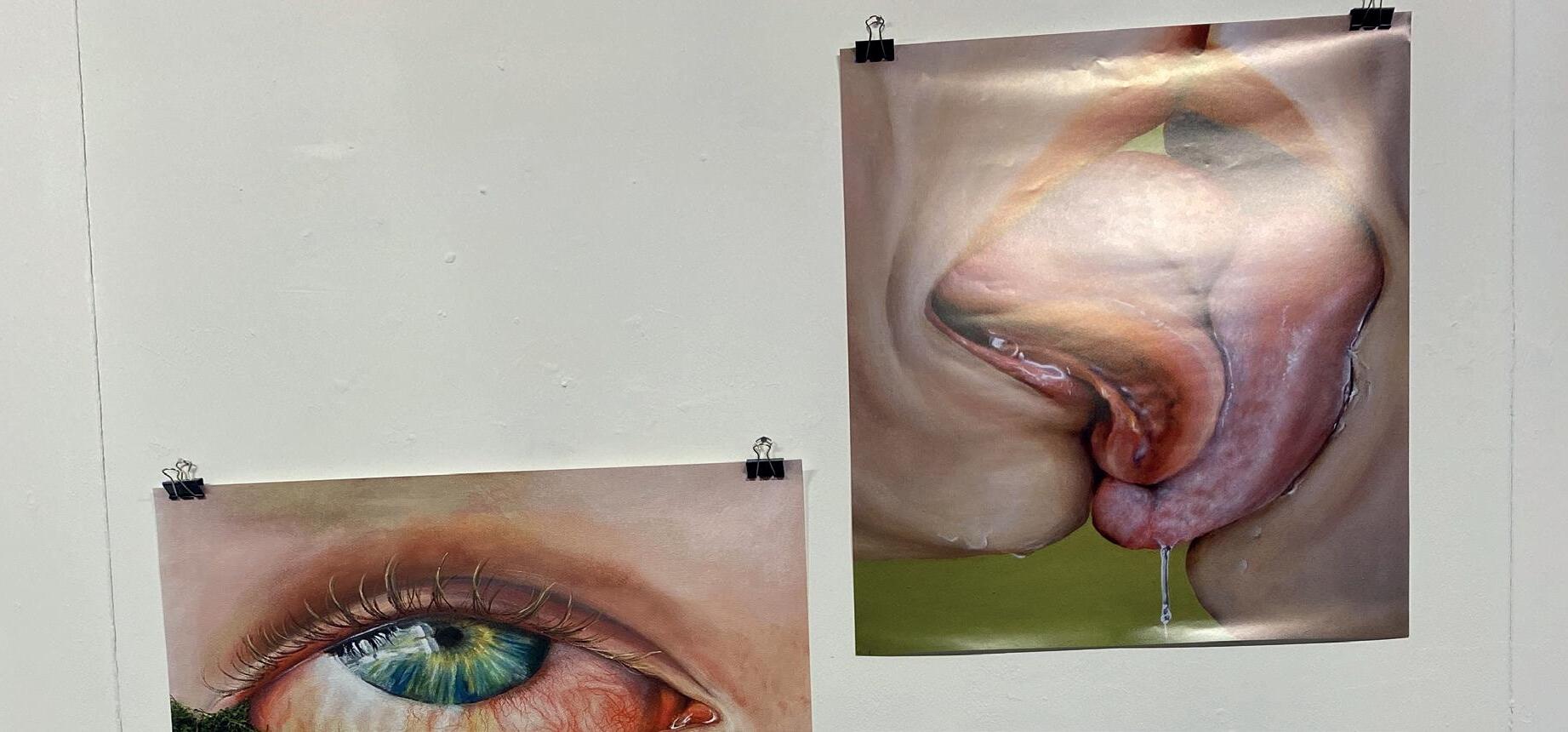
D-Bar was originally closed in March 2020, during which changes to the space were being considered to ensure the venue complied with health and safety standards, according to a 2021 York Vision report. YUSU Commercial Services are now looking into how students can more effectively utilise D-Bar after “sporadic sales”, according to an anonymous


YORK’S AWARD-WINNING TABLOID NEWSPAPER ISSUE 280 16.03.23 “OUR
AIM IS TO DETERMINE WHAT VALUE D-BAR BRINGS”
REVEALED EXCLUSIVELY TO York Vision, D-Bar is being investigated as to what value it brings to students and to “prove that it is worth keeping open”, according to an anonymous tip from
source
student leadership.
a
close to Derwent
Derwent student leader. FULL STORY ON PAGE 5
Vision investigates D-Bar’s failure to bounce back
pandemic
student gallery discusses their latest exhibition
Architect” INTERNATIONAL STUDENT HOUSING CRISIS PAGE 3 UNCERTAIN SCENE. INSIDE THIS ISSUE Will nostalgic remakes ever run out of steam? Interview: Theatre is wonderfully ephemeral Sunshine on Leith: Timeless Nostalgia Nostalgia, Natsukashi, and University Break-ups NOSTALGIA
after the
INTERVIEW WITH NORMAN REA The
“Body
Editor Hannah Willey


Deputy Editor Vacant
Opinion 6
Editor Vacant
Deputy Editor Emilia Vulliamy
Features 24
Editor Vacant
Deputy Editor Vacant
Lifestyle 26
Editor Amber Handley
Deputy Editor Vacant Science & Tech 27
Editor Oliver Fisher
Deputy Editor Vacant
Climate 28
Editor Joe Lee
Deputy Editor Vacant
Sport 30
Editor Jacob Bassford
Deputy Editor Vacant
Screen S3
Editor Jed Wagman
Deputy Editor Vacant
Stage S4
Editor Kayleigh Wittenbrink
Deputy Editor Vacant
Music S6
Editor Alicia Ward
Deputy Editor Vacant
Relationships S7
Editor Otty Allum
Deputy Editor Vacant
Tech S8
Editor Vacant
Deputy Editor Vacant
Food S9
Editor Navya Verma
Deputy Editor Vacant
Books S10
Editor Kate Shelton
Deputy Editor Vacant
Travel S11
Editor Lizzy MacKay
Deputy Editor Vacant
Editor President
Emily Sinclair
Editor Secretary
Kaitlyn Beattie-Zarb
Deputy Editor
Laura Rowe
SCENE Editor
Dan Gordon-Potts
Chief Subeditor Vacant
Subeditor Katie Preston
Subeditor Philippa Salmon
Subeditor Megan Bartley
Subeditor Ashani Padhye
Subeditor Jacob Bassford
Illustrator Olivia Stapleton
Managing Director
Matt Davis
Deputy Managing Director
Vacant
Social Secretary
Alicia Ward
Deputy Social Secretary
Vacant
Technical Director
Marks Polakovs
Head of Multimedia Vacant Opinions
or advertisers.
CITY HAD NO ACCESS TO WATER AFTER POWER OUTAGE
WHAT HAPPENED TO YORK WATER?
VISION INVESTIGATES THE WATER SHORTAGE THAT PLAGUED THE CITY LAST MONTH
BY EMILY SINCLAIR
ON THE EVENING of the 24th of February, homes across York were left with little or no water. The water pressure was low and restaurants, businesses and clubs throughout the city were left struggling.
The cause of the outage was a pumping station being hit by a power outage. This led to anyone in a YO postcode area being desperate for water.
There were reports of shops being left with no bottled water as people began to panic. A student told Vision that as a house they started to fill containers with water just in case it was out all night. “As a house of six, we just couldn’t afford to not have any water”.
Yorkshire Water quickly set teams out with standby generators to get pumps working again
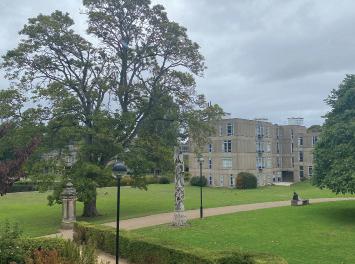
and most of York had their water back within a few hours.
Luke Charters, the Labour Parliamentary Candidate for York Outer, has written to Yorkshire Water requesting compensation for everyone affected by a loss of water.

Under Ofwat’s (the water services regulation authority) no compensation is obliged. In order for compulsory compensation, water pressure must have fallen for an hour or more on at least two occassions in a 28 day period.
Speaking to York Press, Charters said “they’ve made enough profit and it’s causing disruption to York families, so they should just get on and automatically compensate everyone.”
However, it doesn’t look like Yorkshire Water will be compensating any time soon.
A NOTE FROM THE PRESIDENT (OLD AND NEW!)
As I write this Editor’s Note at 12.50pm on Monday 6th of March, I (Katie Preston) am about to pass down the mantle of York Vision President in our AGM on Tuesday.
I’ve had a great time at Vision. I’ve interviewed some amazing students,
covered issues that matter to me like discrimination and mental health, and met some brilliant friends in student media and beyond, but I won’t lie and say that I’m not looking forward to gaining back some of my free time!
Being the head of student media,
The incident was resolved within a few hours and therefore doen’t meet criteria, they said in response.
Yorkshire Water is already facing public criticism at the moment as many residents take to Twitter to complain about an increase in their water bill.
On Twitter, one angry Yorkshre resident said, “just received my new bill. 8.9% increase! How can you justify this?”
Another angry customer said in response, “same, I’m absolutely disgusted. I’ll be rinsing all the water I can this year.”
In response to this complaint, Yorkshire Water said that “there can be many factors as to why a bill can increase.”
As a brief explanation for the increase, they replied on Twitter saying “a reduction of £25m in respect of the penalty has been made to the overall revenue
that we are allowed to collect in the charging year April 2023March 2024.
This means that the penalty has been taken into account when calculating the individual tariffs for the new charging year together with the other adjustments that we need to apply.”
With the current cost of living crisis, an increase in energy and water bills is unfortunately becoming the norm.
However, Yorkshire Water are coming under attack from local residents who can’t work out why the increase has been so dramatic.
whether it’s Station Director for YSTV or Station Manager for URY, or head editors for our fellow print media, is a lot of work. It’s long hours, stress about computers crashing, and, beyond all, hope that your emails get a reply on time for us to print.
I’ve written some
brilliant articles, if I do say so myself, and I’ve loved getting to meet students, get to know them, and work hard with them to get their stories out there! Some of my favourite interviews have been with Issy, an amazing student who I was honoured to interview about their online sexual harassment, and Dylan, who faced racism at Roses ‘22 and was willing to speak to me about it.
Vision has allowed me to do some amazing things outside of campus also. I’ve spoken numerous times on BBC Radio York about the cost of living crisis, which led to my image being featured in a BBC article!
I’ve also been to some great campus events as Vision President, including the BAME Showcase, Comedy Night, Roses 2022 and Sabbs Come Dancing!
I’ve loved my time as Vision Editor/President, and I can’t wait to see what the new team does in 2023 and 2024.
As I write this Editor’s note at 18:44pm on Thursday 9th March I (Emily Sinclair)
have been York Vision Editor President for approximately 48 hours.
I’ve got a pretty tough gig to follow if I do say so myself! I’m honoured to be taking over from Katie and excited for the upcoming year of York Vision. I have a great newly elected Committe with me and I’m excited to work with them and with all of you! I’d love to meet more students whether from the point of view of having a story for us, wanting to get involved or just to say hi it’d be great to hear from you.
My first order of business is this issue! We’ve got a fantastic range of stories this issue, something that me and the new team are really proud of.
Our headline story explores student frustration with D-Bar. We have an interview with new Sports President Tanisha and our features includes an interview with York UCU.
With this, and much more, it’s a read you don’t want to miss.
Enjoy! x
2 Thursday March 16, 2023 NEWS News 2
expressed in York Vision are not necessarily those of the Editors,
Editorial Team, membership,
BY KATIE PRESTON (she/her)
OCCURING ON TUESDAY 14th of March, David Kato College held a panel on “The future of human rights: Research, activism, sanctuary and story-telling” celebrating the opening of David Kato college.
Taking place from 6.15pm to 7.30pm in the Ron Cooke Hub, the panel discussed the diversity of threats to human rights across the globe, including ethnic and racial oppression, violence against women, anti-LGBTQ+ legislation and attacks on political freedom and autonomy.
Asking, “with so many unjust and unfathomable examples of oppression occuring every day, how can we begin to comprehend and respond to such events?“, the panel reflected on the ways in which challenges to human rights can be tackled by “collectively enhancing awareness and activism through academia, art, broadcasting and film-making”.
The event also marked the launch of the York Sanctuary Fund, and was followed by a drinks reception and an opportunity to view an exhibition of artwork and “creative activism” which “reflects upon and responds to the challenges faced by Human Rights Defenders”.
Speakers included Fawzia Ehsani, a PhD student at the University’s Politics department, whose research focuses on the efficiency of regional and international organizations in Afghanistan’s reconstruction after 2001.
LGBTQ+ advocate and Executive Director of Sexual Minorities Uganda Frank Mugisha was also in attendece, alongside Emmy award-winning producer/ director Karim Shah; the Co-Director of the Centre for Applied Human Rights Professor Paul Gready and Mirta Lourenço, is the Chief of the Section for Media Development and Media in Emergency in the UNESCO Communication and Information Sector.
YORK CITY FC DEDICATE GAME
TO ENDING HOMOPHOBIA
BY MIRI HUNTLEY
THE YORK CITY vs Yeovil Town game was a much needed win for the Minstermen, in more ways than one.
Whilst it marked their first win in the last seven national league games, it also marked a change in the overt response YCFC have committed to when it comes to anti-LGBT sentiment - both on the pitch and off.
With the standard York City fans coming in their thousands, and a sizeable amount of diehard Yeovil fans all the way from Somerset, tensions were running high.
This may have been seen as an easy win for York, a well established team who have some great achievements under their belt, but at the moment York are not doing as well as their fans or team would have hoped.
This may have been a factor for the information increase in the team’s foundation being increasingly vocal against racist or homophobic comments among fans.
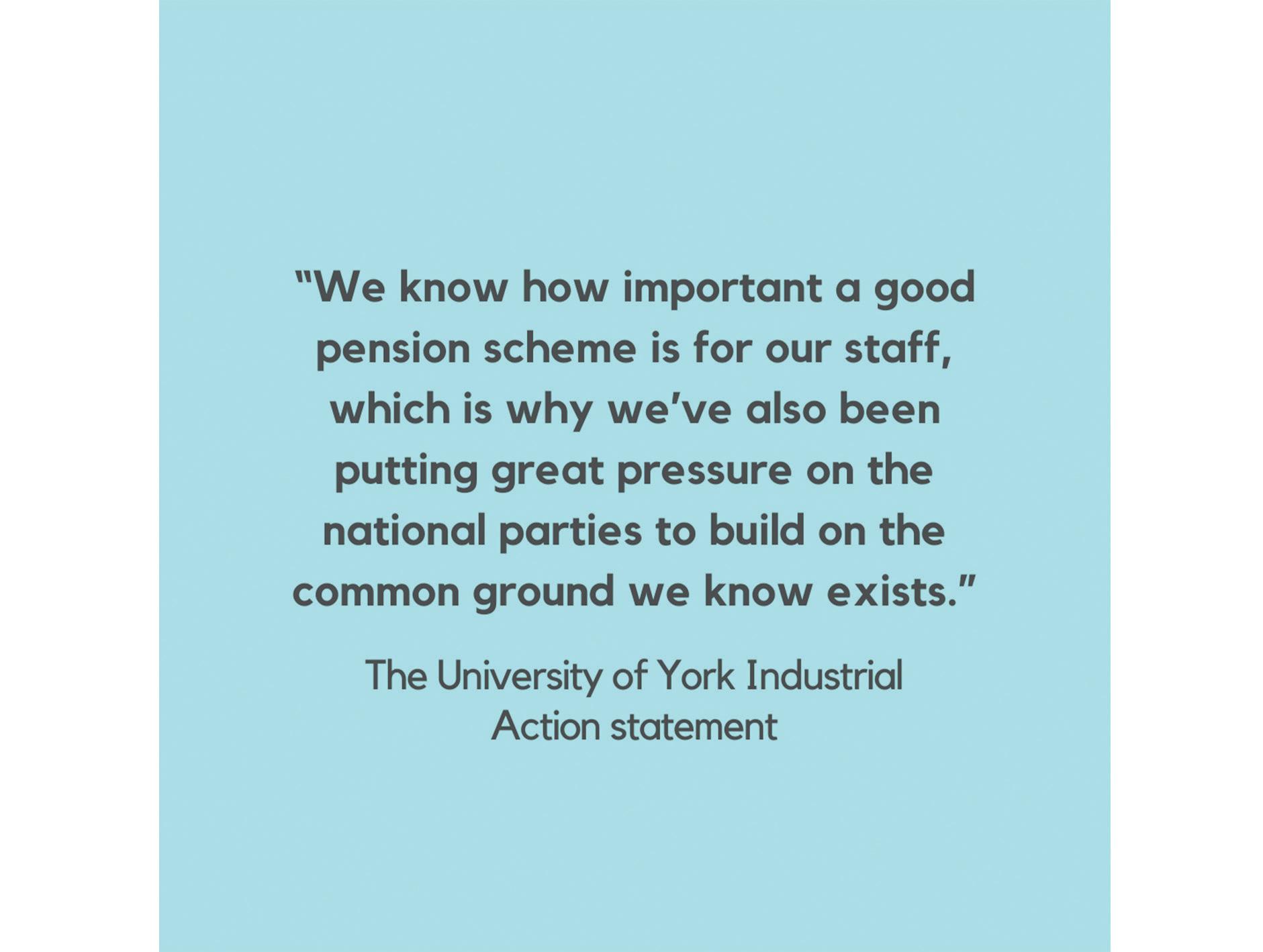
Within the football scene, especially in the UK - what is termed as ‘hooliganism’ is rife.
In a 2009 survey, it was recorded that 70% of fans had heard homophobic abuse during football matches.
However, in a YouGov survey, around 30% of football fans stated that they would feel comfortable seeing two men kissing during a match.
Similarly, for many years during the 1980s,
UK fans were banned from international footballing events because of apparent inevitable outbreaks of violence against the other teams (often in planned fights, away from the stadium), destruction of property and bigoted attacks of minority groups, especially outwardly LGBT people and BAME individuals.
York City is one of the many clubs that has had a sordid history with violence and hooliganism, as a member of the hooligan firm associated with York City was the first person to be arrested at the World Cup in 1968. There have been hundreds of arrests since, and these attacks are often pre-arranged and sometimes deadly, even to passers-by.
In the moments before the match, the mascots (all young members of the local under-16s club Strensall Tigers) were proudly holding the famous flags of the intersex-inclusive progress pride flag and the Football vs. Homophobia logo.
The game had a pre-show from local drag trio Family Shambles, who were invited to watch the game in the south stand, a notoriously passionate group of York fans.
The Press referred to the designation of the fixture as “ a nice gesture,”, however the culture of homophobia and bigotry in football is continuing to be addressed within the football scene.
According to a YouGov survey in 2019, half of Britons and football fans consider homophobia to be a serious problem in professional football.
However, 48% of football fans believed that
homophobia in football is significantly better than ten years ago.
Football vs. Homophobia was created in honour of Justin Fashanu, the first professional footballer to be openly gay, and who took his own life in 1998.
It seems we have made huge progress in general for LGBT rights- but the football community is trailing behind massively. Still to this day, there are still only 7 recorded footballers who have ever been open about their homosexuality in the UK football leagues- and 4 of them have been in the last ten years.
YCFC blogger Ben French highlighted the way that the way that York City have made a real connection with the young people and wider York community:

“The Football vs. Homophobia campaign did really well in reaching the important audience of football.
There was a local school competition in York to design a pride training shirt for the York City mens and womens games on 25 February- it really captured the imagination in the community.”
As we saw on Saturday, a win for the team can, and must, happen in association with a win for a more LGBT-friendly culture.
INTERNATIONAL STUDENTS AT A LOSS FOR HOUSING
INTERNATIONAL HOUSING
CRISIS FOR YORK STUDENTS
 BY KAITLYN BEATTIE-ZARB
BY KAITLYN BEATTIE-ZARB
AS COST OF living, and increasing rent and electricity costs, caused a concerned demand for campus accommodation earlier this year, York Vision investigated details of this January’s race for housing.
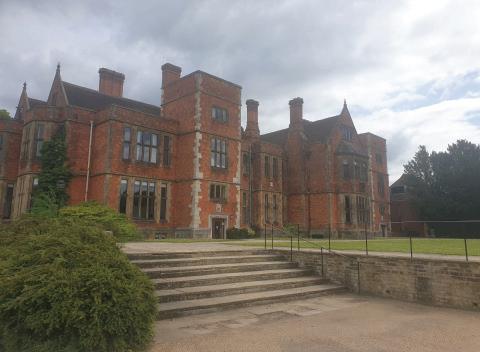
The opening of returner housing is always a dramatic day of quick applications and even quicker room bookings, as second and third year students race to secure the University’s limited on-campus rooms. This year, over 1480 students eagerly competed for the coverted rooms.
However, when the long-anticipated January 9th application hour eventually arrived, even the most ready applicants were met with fully booked rooms mere minutes into logging on.
The website itself crashed within seven minutes, although the University of York Information Governance Team stated upon request that “the website did not crash.”
They note that students were unable to pro-
ceed with bookings if rooms had been fully subscribed, but that due to immense demand “the system was unable to show that the room was fully booked.”
Further problems evolved when the website showed that applications had been logged and time stamped, when in fact the room selected was full and unable to be booked. Luckily, 200 more rooms were received than advertised - although it’s worth mentioning that this number doesn’t seem to note how many students cancelled applications.
These unsuccessful returners were left to face York’s housing market where high rent, unstable tenancies and a search for roommates complicates a student’s right to shelter. These struggles are exacerbated for international students, who are more at risk of being left homeless if the private market proves unsuccessful, especially when international students making up 5660, or 27%, of the student body, and 15% of the University housing applicants.
Of the 235 international applicants, 75 were left in the dark, equating to a 31% chance of
getting housing, compared to 28% for home students.
While this doesn’t seem necessarily dreadful, the University process ultimately underestimates the trickier circumstances facing such a key demographic - that they certainly seem intent on attracting.
International students are more likely to be searching for accommodation on their own, with language barriers and difficulties finding UK guarantors. They are more likely to need summer lease options, limiting their options and driving them towards more convenient but expensive options. Even housing applications may be harder if completed in different time zones over Christmas break.
With risks of having to pay for a university guarantor or pay the annual rent upfront, alongside already sky-high tuition fees and a lack of government support or student loans, international students face a complex web of concerns in their simple mission of continuing study alongside their peers.
NEWS 3 Thursday March 16, 2023 DAVID KATO OFFICIAL OPENING
YORK CITY COMMITS TO ENDING HOMOPHOBIA
DURHAM UNI BEATS SOUTHAMPTON IN UNIVERSITY CHALLENGE QUARTER FINALS
THE PALATINATE HAS reported that Durham University has won the first match of the quarter-finals of University Challenge against the University of Southampton.
Dubbed a “close contest”, Durham achieved a final score of 165, beating Southampton by only 30 points. Palatinate reports that the teams were quizzed on everything from national parks to video games, with the winning team still having to win one more match to proceed to the semi-finals. Durham’s team consists of students Harry Scully, Chloé Margaux and Bea Bennett, captained by Alex Radcliffe. Good luck to them all!
WARWICK UNI PAYS COMPENSATION TO POST-GRAD STUDENT WITH CANCER
THE BOAR REPORTED that Warwick university has paid compensation to Riham Sheble, a postgraduate student, for their initial denial of her request to extend her coursework deadlines following a cancer diagnosis.
Diagnosed with a rare form of cancer in 2021, Sheble has been paid £12,000 by the university for the “distress and inconvenience” caused by not granting her deadline extension. As Sheble is an international student, the lack of extension meant their visa was due to expire, meaning she would have been forced to leave the country.
The Boar have reported that the request was originally rejected in spring 2022, but reversed that summer.
SHEFFIELD
UNI £4M IN ARMS TRADE
FORGE PRESS HAS revealed that the University of Sheffield was a recepient of £4 million from six aeronautical companies, engineering researchers, and defence contractors within the last year.
It was also reported that direct funding from the UK and US governments for defence and security research was given to Sheffield, exposed by activist group Demilitarise Education.
Forge Press stated that this grant of £1.2m was awarded for an “intelligence, surveillance, and reconnaissance’ engineering project in 2020.
EXCLUSIVE: THE NORMAN REA GALLERY ON ‘BODY ARCHITECT’
BY MARTI STELLING (she/her)
OCCURING ON MONDAY
6th March, York Vision interviews the Norman Rea Gallery on their latest exhibition ‘Body Architect’.

How would you describe your latest exhibition, ‘Body-Architect’?
We knew that ‘Body-Architect’ was going to be the last exhibition that Vienna and Sophie curate, so we wanted to use this opportunity to select works that varied in textures, materials and sizes. We thought that the role of the body and the manifestation of the self was an interesting concept to interrogate with these formalities, and to translate these into the gallery space is so special!
‘Body-Architect’ is an exhibition centred around the artistic depiction of the human body, aiming to highlight the manifestation of the self and how we oscilliate between the spatial environments society has created for us.
The Norman Rea Gallery aimes to flex this discourse to exhibit alternative portrayals of the body in creative practices such as dance, design and abstraction to provide the audience with a more nuanced understanding of the self as a transformative act and participation with the arts. Our bodies aren’t singular, objectifying entities, but transitory experiences.
chitect’ in November last year. We both love the art historical discourse about spectatorship, and the relationship between the artworks. We thought that the role of the body was therefore an accessible and interesting way to visualise these concepts, allowing us to think about ourselves and our spatial environments.
What are you most excited for ahead of the launch?
We’re excited for all the supplementary activities and events we’ve organised that extend the theme of the exhibition into different spaces! We’ve got a zine-making workshop coming up, as well as a contemporary dance performance, and a standup poetry event. It’s really great to be able to create more events that keep the experience and conversation of the actual exhibition alive, allowing more people to access and enjoy it.
What happens behind the scenes in planning and setting up an exhibition?
oratively decide where everything goes, and work in groups to hang and display it. Captions and decorative bits are added, and voila! We arrive at the gallery early on Monday afternoon to assist the musicians and tech team with setting up, and finish any last-minute tasks such as setting up the merch and drinks table in the foyer, before doors open to students and the public.
What’s been the most challenging part of setting up the exhibition?
Curation can be difficult sometimes because all of our members individually source pieces, so we’re never entirely sure how all the artwork will look together until we lay everything out on Install the Saturday before. Although the technicalities can be difficult, I think one of the biggest challenges is pulling together the exhibitions and all of our other events while studying degrees full-time. The commitment that we give to the gallery honestly feels like a full-time job by itself, as we’re constantly planning and working towards each exhibition for weeks in advance.
How can people get involved with future exhibitions?
ANTI-WEAPONS
GROUP TOOK OVER LANCASTER UNIVERSITY
BUILDING
SCAN LANCASTER HAS reported that Demilitarise Lancaster took over the Charles Carter Building on the 15th February, with all teaching scheduled in the building rearranged. This follows the activist group’s three-day takeover of the Margaret Fell Building in December, with the group telling SCAN that they are fighting for a better university and a better future. This includes the UCU’s struggle and the fight against the arms trade.”
‘Body-Architect’ marks the final exhibition of the 22/23 Committee. Since the gallery’s conception in the 1976, Norman Rea intended to foster an artistic hub within the University of York, creating a space where young artists could exhibit their work in a student environment.
Now in 2023, Norman Rea Gallery has kept the tradition to give young creatives a platform for their artistic practises, to enable a stronger connection between the self and the current social, cultural and political enviroments.
How did you decide on the theme of this exhibition?

We first began thinking about what has now become ‘Body-Ar-
We begin with a concept for an exhibition, which we develop until we’re able to write a cohesive press release. From there, we brief our members on the theme (using visual examples of elements that have inspired us), and explain how and why we came up with it! Members then find and contact UK-based artists that they feel reflect the theme, using email and message templates that we formulate, linking the press release and additional information.
We log all the artists that we contact and update their status during our following weekly meetings. By the time the exhibition is launched, we will have confirmed 25-30 artists to participate, and will be focused on other elements, such as sourcing decoration, interactive elements, and live media. At the same time as this is going on, we also plan any additional events that we want to happen in the weeks following the opening night.
Our committee and members come together with all of the artwork on the Saturday morning before the opening night to curate and install everything; we collab-
They can sign up to become a member of the gallery on YUSU, and then come along to our weekly meetings - it’s as simple as that! We welcome students from all degrees and backgrounds, and love the exciting and diverse ideas that our community brings.
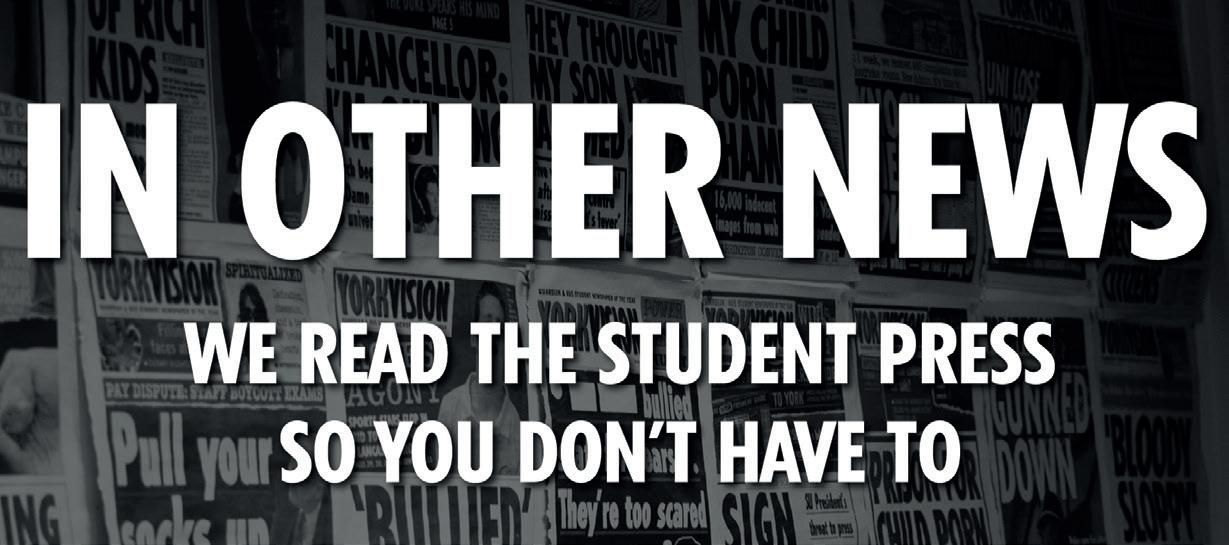
It’s fine if your interest isn’t exclusively ‘fine art’, because our opportunities and events are so much more than the traditional idea of university art spaces. We’re constantly looking for musicians and DJs to perform at our events live, and writers for our blog too!
Any exclusive hints for future exhibitions?
Nope, sorry! Our committee is about to go through a handover, but I’m sure there will be plenty of exciting exhibitions next year - be sure to keep an eye out…
4 Thursday March 16, 2023 NEWS
MARTI STELLING
IMAGE:
FUTURE OF D-BAR UNCERTAIN
BY KATIE PRESTON (she/her)
REVEALED EXCLUSIVELY TO York Vision, D-Bar is being investigated as to what value it brings to students and to “prove that it is worth keeping open”, according to an anonymous tip from a source close to Derwent student leadership.

D-Bar was originally closed in March 2020, during which changes to the space were being considered to ensure the venue complied with health and safety standards, according to a 2021 York Vision report. YUSU Commercial Services are now looking into how students can more effectively utilise D-Bar after “sporadic sales”, according to an anonymous Derwent student leader.
Bringing into question whether the events being held by YUSU and Derwent reflect what students want, D-Bar’s purpose is now being re-evaluated.
In a Save-D-Bar petition on July 22nd 2021, 300 signatures were amassed in a singular day. Prior to this, YUSU took over the running of the bar in September 2018 from the University, with D-Bar then closing during the first Covid-19 lockdown cycle alongside V-Bar and Courtyard.
In a joint statement from YUSU on the reopening of D-Bar on 29th July 2021, it was stated that “YUSU are currently recruiting more staff and working on a training and induction plan for them to ensure that venues can gradually reopen. This is part of our commitment to get D-Bar back open as soon as it is safe to do so.”
The University also committed to “try[ing] to ensure that D-Bar is one of a range of venues that reopen over the course of the coming academic year.”
Currently, D-Bar is used for the Activities Thursdays, run by Activities Officer Rohan Ashar, and for social events run by the LGBTQ+ Network, amongst others.
Discussing D-Bar in 2023, a YUSU staff member said:
“Currently D-Bar is open from Monday to Friday. YUSU runs two nights and Derwent college has a regular night booked in on a Friday. We see, when large-scale events are run at D-Bar (such as the LGBTQ+ Society event during the World Cup or club nights such as Club D), students really engage and if this is all that students want from D-Bar, we should use the venue for those purposes.
“Our aim during term three is to determine what value D-Bar brings to students and to expand upon that going forward. We reached out to the college to help with this as they have a direct connection with their students and hopefully can get an insight to how D-Bar can engage with not just Derwent college but all students.”
Speaking to the Derwent student, however, a substantially different sentiment was expressed:
“There is a proposal that D-Bar going into 2023-24 will only open if an organisation/society/committee can guarantee that there will
be an element of cost-covered by the event; if D-Bar makes a loss, that organisation will be liable for costs.”
Speaking to Vision, a YUSU staff member said:
“We want D-Bar to be full, we want it to be busy. We want it to be open every day - that would be amazing! But what we don’t want is to just have it open and then nobody go to it because it would be sad, and equally a big financial drain on YUSU.
“The responsibility that YUSU has from a student perspective is massive, and Commercial Services are here to add funds that pay for all those really great things, and if we start removing funds by having a venue open just for the sake of having it open, it detracts from the purpose. I think we are on the same page with the college, it’s understanding how to get to the end goal which I think everyone is struggling a little bit with.”
The Derwent student also discussed alleged lack of care put into D-Bar after its reopening:
“There were plans to refurbish D-Bar in 2019 but these were shelved in Covid and have not been acted upon.”
YUSU agreed with the lack of investment put into D-Bar after the pandemic, stating that:
“When Derwent JCRC is talking about underfunding of that area, I agree! I got sent some plans about what the University was going to do with D-Bar pre-Covid, and it looked amazing, but it’s been shelved and stopped. So the underfunding is right, it’s 100% right. The place could be so much nicer, but it’s not our venue to fund. I think the problem with that kind of thing, what the college is frustrated at, is right, but it’s aimed at the wrong people”
Derwent also raised concerns to Vision about a lack of maintenance and upkeep in D-Bar after its reopening:
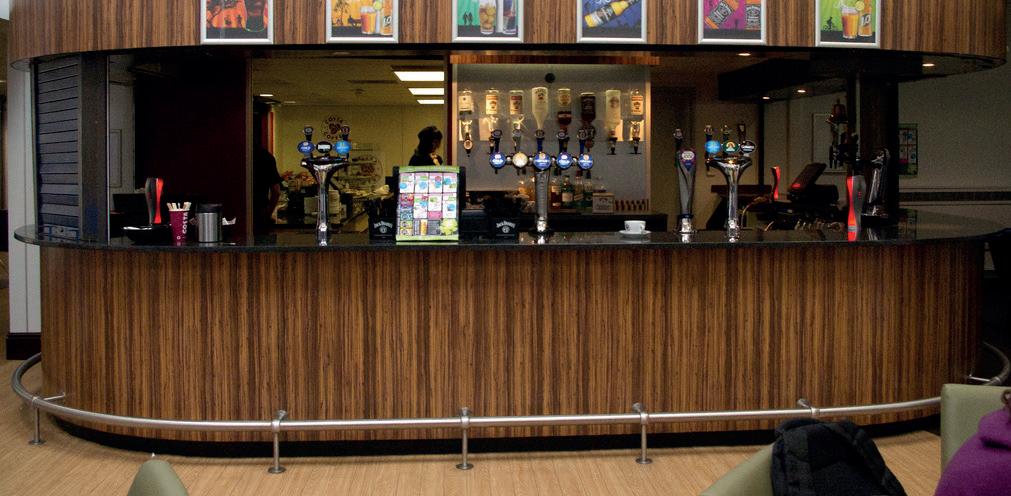
“In August 2022, some of the taps were broken in D-Bar and have not been fixed, reducing the quality of products on offer. This raises questions about if YUSU deliberately did not fix them because they knew they were thinking of closing the bar.”
YUSU agreed with the frustration of unfit-for-purpose draught pipes in D-Bar when speaking to Vision:
“All the draught pipes are super old, and need replacing, and the quality of the beer is so poor.
“We’re not allowed to put a nail in a wall, and in some venues we can’t put blu-tack on the walls as the paint is made with asbestos, so to do anything we have to go through so many hoops.”
Also attending the meeting was Union President Pierrick Roger, who stated that:
“I think it’s a point to clarify that when people say D-Bar, people are talking about the entirety of the space, and YUSU only controls the bar itself.
“When the bar opens, the space in itself is still open for people to use whenever they want, we don’t control that necessarily, but whether we justify opening a bar for people who don’t want to buy anything, that in itself is not justifiable. If people don’t want to buy from the
JACK DAVIES
bar, then the bar isn’t going to be open - but it doesn’t mean that people can’t have access to it in itself.”
However, the student close to Derwent College’s leadership believes that D-Bar is being undervalued by YUSU:
“In August, every YUSU bar was given a niche they had to run with - D-Bar was given Sports and Societies. Yet allegedly, it was also told by YUSU that they were not allowed to show any sporting matches or fixtures on any of the screens as that was exclusively the right of Courtyard, the flagship venue. This raises questions about how D-Bar was supposed to successfully carry out its ‘niche’ and seems to be absurd.”
“Furthermore, Derwent JCRC believe this decision is being based off of takings from term 2. It is well known that term 2 is always the lowest takings as in Term 1, Freshers’ Week turnout and the weeks following are high, as are term 3 with the end of term events. It seems unfair to base these decisions off of term 2.”
Union President Pierrick Roger said:
“From my perspective, we can’t subsidise free booze, it makes no sense. Our charitable objective is not to get people alcohol, and if we’re running the bar at a loss, just run that for two days and that’s an entire Part-Time Officer’s budget for the year gone. It’s not possible for YUSU to foot the bill for everything. And if we did, it would be really illegal! I’d love it if everyone could get free stuff! But it’s not how we operate.”
The Derwent student expressed their anger at the handling of D-Bar as it goes into this transitional period:

“The whole thing seems to be a mess. A seemingly deliberate underfunding, underinvestment by YUSU to a college bar that has existed since the founding of the University and an integral part of Derwent College. It seems that the well-being and community of the college and students is not a good enough reason to stay open, and raises questions about YUSU’s stated aim of not-for-profit, for students.”
In response, YUSU stated that:
“YUSU’s statement of ‘not for profit, for students’ is a really tricky one, and it’s something that we war with internally. The statement is 100% correct as in YUSU, the entirety of YUSU, is not for profit, and it doesn’t make profit, it’s here to serve students’ needs. The way that YUSU works isn’t free, it doesn’t matter what it is, it costs money.
“The way that YUSU funds itself is through revenue streams, one of which is Commercial Services. Commercial Services is in this really difficult situation where it is for profit: if it doesn’t make profit, then there’s no point in actually running bars. A lot of these bars were being shut, and YUSU took them on because we believed, not that we could make loads of money, but that it could offer something to students.
“When we went to the committee, it wasn’t in the view of ‘sort this out or we’ll shut D-Bar down’, it was to ask them to help us.”
UOY
TO LEAD R.E.A.L RESEARCH UNIT
BY KATIE PRESTON (she/her)
ANNOUNCED ON THE 1st of March, the Centre for Health Economics (CHE) at the University of York has been chosen to lead a “major research programme aimed at improving the quality of decision-making in health and social care”.
Reported on the University website, the team will receive more than £3.7m funds over the course of seven years from The Health Foundation to set up the R.E.A.L Research Units programme.
The University has reported that the York team will work in collaboration with researchers from Kent and Aberdeen universities, and the Scottish Policy Research Exchange.
The research unit will “develop and deliver an ambitious economic research programme focused on the supply of health and social care in England”, aiming to improve sustainability and equity of care.
UOY SIGNS CROSS-SECTOR STATEMENT ON EU
BY KATIE PRESTON (she/her)
REPORTED ON THE 2nd of March, the University has signed a cross-sector statement “urging rapid progress on UK association to EU programmes”, including Horizon Europe, Copernicus and Euratom.
The statement has also been signed by the British Heart Foundation, the Institute of Cancer Research, UK Dementia Research Institute, and the Russell Group, amongst others.
Professor Matthias Ruth, the Pro-Vice-Chancellor for Research at the University, stated that “working together, across geographical borders and disciplines, leads to remarkable breakthroughs, quicker progress, and the exchange of knowledge and skills.”
Thursday March 16, 2023 NEWS 5
IMAGE:
V
SAYS...
YORK VISION HEADS TO SPANC 2023 IN GLASGOW!
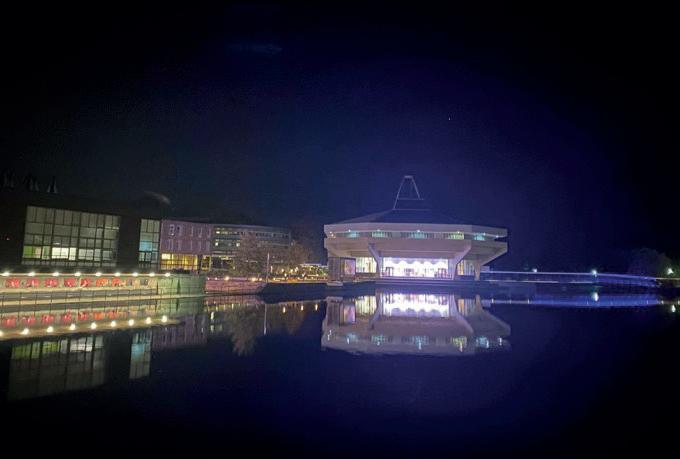
IT’S THAT TIME of year again - the Student Publication Association National Conference (and awards ceremony) is geared up to be in Glasgow this year, meaning that the Vision team will be trekking from York to Scotland at the end of March.

Celebrating student journalists from up and down the country, SPANC is always a great place to meet other editorial teams, attend brilliant workshops from journalists in the field and celebrate everyone’s hard work and dedication to student media.
This year, Vision has been nominated for Best Newspaper Design, best Science Piece (well done Emily!) and the revered Best Publication! Look out for us in Glasgow!
YUSU ELECTIONS DEBRIEF
ELECTIONS 2023 ARE over, candidate posters have been taken down from campus, and student media can effectively breathe a sigh of relief from weeks of non-stop coverage.
But did 2023 chalk up to previous years? It depends how you look at the elections cycle. In terms of sabbatical officer diversity, 2023’s newly elected team is one of the most diverse on record, with four out of the five officers being from a BAME background, and three of the five officers being women - a brilliant change from the previous all-white, all-male years.
However, voting turnout was incredibly low this year, especially when compared with 2022’s engagement which had one of the highest voting turnouts in the last decade.
WHY IS SPRING TERM SO HECTIC?
SPRING HAS SPRUNG in York (though you wouldn’t know it from the weather!) and with that comes an aggressive amount of deadlines, formative stresses and general burnout that seemed to come completely out of nowhere.
Whilst Autumn term seemingly lulls at the beginning and becomes stressful mid-way through, for third years at least, Spring term almost seems to begin with the intention of causing emotional distress.
Whether that be through Monday week one deadlines, a full-speed-ahead approach to learning or having to trek to 9AM seminars in the blistering cold, Spring term is by far the worst term, and the bliss of the Spring vacation is almost criminal.
For some subjects, Spring term is made worse by having to do a plethora of exams in January. Barely weeks after the wrapped up warm and fuzziness of Christmas, suddenly students are sitting hour-long Chemistry exams and dreading the fact that they procrastinated on revision ..in order to enjoy the festive period.
WHY THE TERM ‘PRO-LIFE’ IS MISLEADING
Wade has nothing to do with protecting lives: it has everything to do with controlling women.
to live below the poverty line.
- Parents are 3 times less likely to have full-time work.
THE CAREFUL CONSTRUCTION of the language used around abortion villainises women’s agency. The debate around abortion has been categorised into ‘pro-choice’ versus ‘pro-life’.
By framing itself as ‘pro-life’, the anti-abortion side attempts to make those in favour of women having autonomy over their own bodies seem ‘anti-life’. Claiming that they protect lives, supposed ‘pro-lifers’ implicitly suggest that the opposing side are somehow ‘anti-life’. The term is misleading at best, and dishonest manipulation at worst.
But why is this term ‘pro-life’ dishonest? Quite simply, ‘pro-choice’ is not and has never been ‘anti-life’.
Pro-lifers claim to protect lives despite the risk that carrying pregnancies to term has to many women’s mental and physical health. They choose to ignore the deaths of women forced to go through dangerous pregnancies in favour of foetuses. They want all pregnancies to go to term even if the mother dies. Not very ‘pro-life’ of them. Despite claiming to protect lives they somehow fail over and over again to protect those who are already alive. It would seem that it’s a lot easier to defend the ‘lives’ of cells that do not have their own voice.
‘Anti-Choice’
All those who consider abortion make a choice based on the quality of life. This can be their quality of life, their family’s quality of life or even the foetus’s quality of life. These decisions are made with the protection of lives always at the forefront of the mind. You can believe the choice is wrong, but you cannot call it anti-life. So, if no one is anti-life, then no one can be pro-life. The term is meaningless, intended to try to win a ‘morality’ battle through brainwashing.
It is not ‘pro-life’ but ‘anti-choice’.
The devastating reversal of Roe v.
It attempts to remove individual agency through its claims to protect lives. You don’t have to look very far to see that this is more dangerous to lives than abortion will ever be. Abortion is healthcare which saves the lives of many people. To criminalise this is to deliberately endanger the lives of people who can get pregnant.
There are no equivocal laws for cis-men which control their bodies and reduce their agency. And nor will there ever be.
According to a recent survey, one out of every four ‘pro-life’ Americans would identify as pro-choice if the alternative were ‘anti-choice’ instead. The propaganda of the terms used is clearly impactful, which is why it is important that we use terms which are reflective of the stance each side holds. Anti-choice is a far more honest and accurate description than ‘pro-life’, and using this term may alter mindsets over time.
‘Pro-Birth’
Examine the actions of the socalled pro-lifers and it becomes clear that pro-choice does far more to protect lives than the anti-choice parade ever has.
They are not pro-life; they are pro-birth.
Once the baby is born, they stop caring about its well-being. Whether it thrives, or even just survives, it no longer matters to them as soon it cannot be used to control women’s bodies.
They don’t care about the women who die in labour, or those who suffer trauma from the birth. Definitely not those who suffer postpartum depression. They don’t care that they may have just plunged a family into poverty, or that they have decreased many families’ quality of life.
The lack of care for life is shocking from a group which claims to protect lives.
Being forced to carry an unwanted pregnancy to term means:
- Families are 4 times more likely
- Parents are 6 times more likely to receive public assistance.

The facts do not lie. This isn’t prolife, it’s pro-poverty, and it is appalling.
Experiencing poverty in childhood has been shown to have lifelong consequences for the health of people, even into adulthood. The lack of care pro-birth has for these children after they have been born is staggering.
If these people truly cared about life, they would place as much value as they do on foetal development upon structures which support a human being from 0 to 100. Examples of what they should be doing to solidify themselves as actually pro-life are pretty easy to think of.
Things that pro-birth people should focus on that will actually save lives:
Suicide prevention, fostering children, raising mental health awareness, pushing for free school meals, and definitely not advocating against a healthcare system which saves lives.
So how is pro-choice doing more to protect lives?
Quite simply, it advocates for a form of healthcare which protects the lives of pregnant people as well as the quality of life for the unborn child.
Banning abortion will not stop abortions - it only stops safe abortions. Women will die because of unsafe abortions.
You aren’t trying to save lives. You’re not trying to improve the lives of people. You’re trying to take away autonomy. You are putting women at risk. You are causing unnecessary deaths.
Being pro-birth makes for great propaganda. It makes for ‘great’ debates. But it is cruel and inhumane. It is not justice for the unborn. It is not protecting lives. It is a manipulative tool to control the living. And that is definitely ‘anti-choice’.
OPINION
YORK
ısıon
6 Thursday March 16, 2023 OPINION
KATIE PRESTON (she/her)
LAURA ROWE DEPUTY EDITOR (SHE/HER)
VULLIAMY
WHY ON-CAMPUS SPACES ARE
SO IMPORTANT TO STUDENTS
MY TOP 5 favourite study spaces and why I find them so useful.
The University of York has a wide selection of study spaces to choose from across the two campuses. In fact, the University website boasts over 1,000 singleand-group study spaces across the Library and other University buildings.
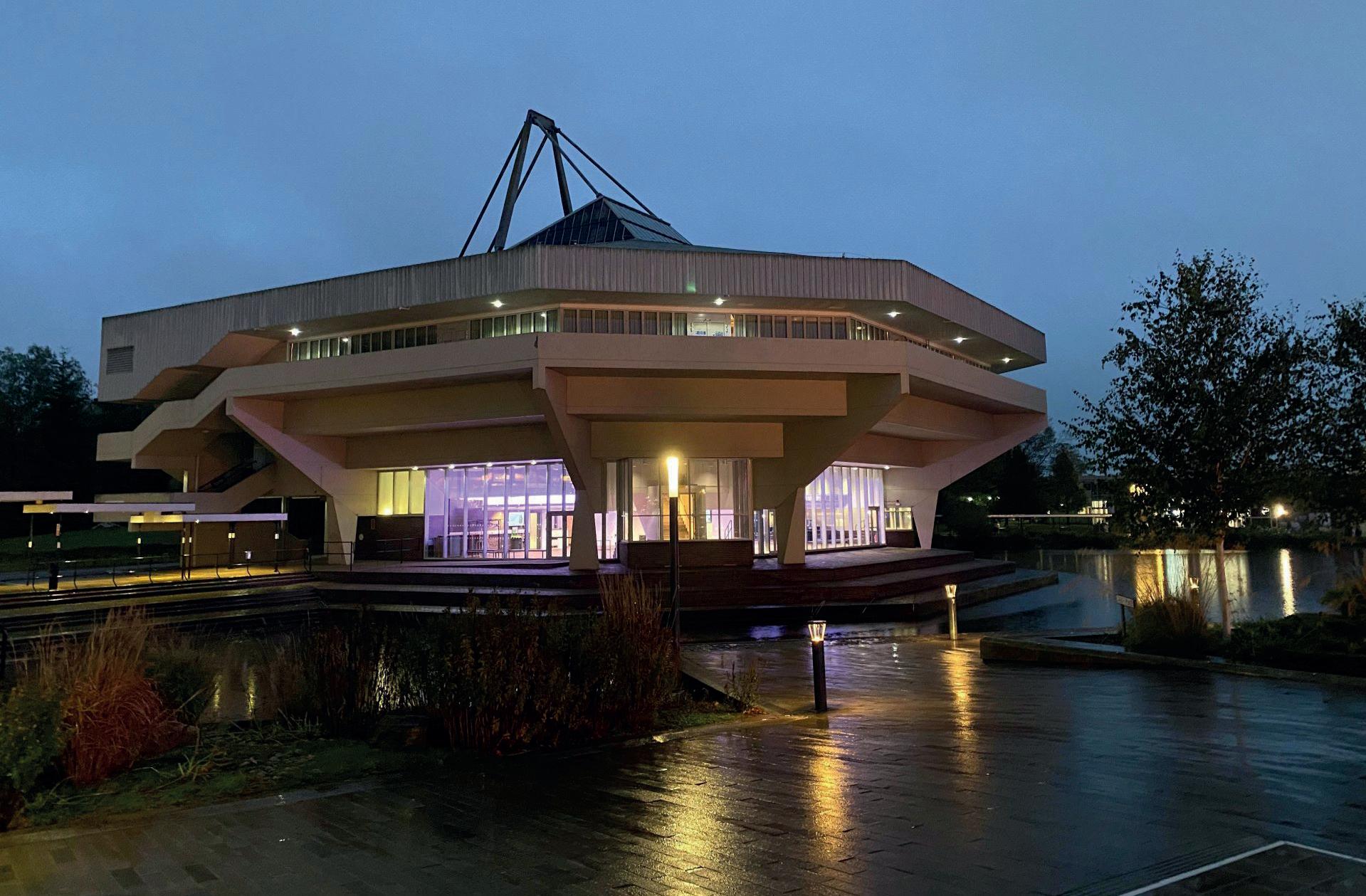

During my first year I was in university accommodation with a lovely desk and warm room, so I didn’t often make use of the spaces around campus. I was about 5 seconds from my accommodation so why not study in the comfort of my room?
Well, I quickly discovered this year that my desk was consider-
ably smaller (about half the size), my room absolutely freezing, and I have to walk much further to campus every day. It just makes a lot more sense to stay on campus and work.
And I have to say that I’ve been pleasantly surprised by how much I enjoy it (and much more work I get done when I can’t just chat to my housemates).
1. At the top of the list is, of course, the Library. It’s the obvious choice with 3 different sections and all the books you could need.
2. Spring Lane Building is next which has a silent study space upstairs and spaces for more relaxed work.
3. The Church Lane Building has a similar feel but even better as its right next to the Link for when you need a much deserved break.
4. If you’re on East, the Piazza is always a good choice with its
ample spaces.
5. King’s Manor is my last pick. It’s a bit of a trek but if you’re looking to romanticise your uni life then its absolutely perfect. It’s in town so it provides a nice change of scenery and the building is much nicer than the likes of Derwent! Great, but why do I use them? And why is it so important that the uni has them?
I think it can be broken down into 3 reasons.
1. Helps with productivity –being surrounded by people who are working can help motivate you to do some work and it means that you don’t get as easily distracted
2. Work and home can stay separate – you don’t just see your room as an office, it is a place for relaxation – and that can help you sleep better.
3. Helps you to be more organised – if you know that you can
BOYCOTTS DO WORK
BY LAURA ROWE
DUNGEONS AND DRAGONS is a game based almost entirely around the creativity of its players. The boardgame’s publishers’, Wizards of the Coast, recent decision to change the Open Game License in One D&D (in the next and current edition) threatened this crucial part of the game. This led to many players boycotting D&D.
be in a space for a set amount of time then you can organise your work around this.
All these help your mental health – they help you keep on top of your work, stay less stressed and make other spaces and time more fun. Having that work life balance can be really hard to manage but maintaining a dedicated space to work on campus can go a long way to help.
Bottom Line: Campus study spaces can help support students’ mental health - and keep us on track with deadlines!
CHILDBIRTH IS MORE DANGEROUS FOR POC WOMEN
there can be no doubt that this is a violent display of racism.
THE 2017-19 MBRRACE REPORT found that Black women are four times more likely to die in pregnancy or childbirth than white women in the UK. The charity Birthrights is concerned that overall “this bleak picture has not changed in over a decade”.
The report found that Black, Asian and mixed-race women have a higher risk of dying in pregnancy, with Black women four times more likely than white women, and Asian and mixed-race women being twice as likely. In 37% of cases improvements in care may have saved their lives. In other words, if doctors, nurses or midwives had intervened then these women may not have died. For women of colour to be affected so disproportionately
The report shows the risk of dying in pregnancy or the year after childbirth, for women is:
White groups - about seven in 100,000
Asian - 12 in 100,000
Mixed ethnicity - 15 in 100,000



Black groups - 32 in 100,000
Healthcare is being withheld from women of colour, with many reporting that they were ignored or told they were overreacting when complaining of pain. These personal experiences in combination with the appalling statistics emphasises that women of colour’s pain is not being taken seriously and so is ignored.
The most recent report covers 2018-20 where the statistics have only changed slightly. The risk for Black women was 3.7 times more than the risk for white women, and for Asian women was 1.8 times
more. These numbers are not reflective of POC receiving better care but are in fact the opposite. Between 2018-20 the deaths of women in childbirth was 24% higher than 2017-19. More women died, not less. The number of cases in which improvements to care ‘may have made a difference to the outcome’ rose to 38%.
The MBRRACE report found that in 2020, women were 3x more likely to die by suicide during or up to six weeks after the end of pregnancy compared to 2017-19.
The care being allocated for women is clearly lacking and causing preventable deaths. Not only are WOC more likely to die in childbirth – a statistic which has barely changed for years – but even more women are dying in childbirth or in the 6 weeks following. These deaths can and must be prevented.
I do, however, want to make it clear that the increase in deaths
cannot be blamed on individual nurses, midwives and doctors. The number rose during the pandemic where the pressure on the NHS increased incredibly. The government is not providing the funding or support to these healthcare workers leading to many unnecessary deaths across all fields.
The racism faced by POC during childbirth remains unacceptable and fatal. It must be stopped.
Bottom Line: Women of colour are disproportionately affcected in an act of dangerous prejudice.
Rumours, statements, and insider leaks showed Dungeons and Dragons was trying to impose new restrictions and control over third-party creators. They wanted to make players pay to use their own ideas. This dreadful decision led players to cancel their D&D Beyond subscriptions en masse.

The players pressured the company, using their agency to ensure that the decision was reversed.
This real-world example shows us that if we hold companies accountable for their actions, we can make steps forward. Following their example we need to continue to pressure companies into being more environmentally friendly, having proper working conditions and paying their workers properly.
ANTI-HOMELESS ARCHITECTURE
BY LAURA ROWE
FROM SPIKES UNDER shop windows, to bus-shelter seats which lean forward, from metal benches with solid dividers to bollards under bridges: urban spaces are being designed to reject human bodies.
Spaces are being designed to deny even the smallest bit of comfort to those who have to sleep on the streets.
Ocean Howell, Tutor of Architectural History at the University of Oregon, says that “when you’re designed against, you know it… The message is clear: you are not a member of the public, at least not of the public that is welcome here”. This is the case of all defensive architecture.
Anti-homeless or defensive architecture is not a product of thoughtlessness, it is an organised unkindness. A curated act of cruelty funded with the motive to harm.
The hostile nature of this architecture makes us more hostile. It makes us forget to care. Anti-homeless architecture is inhumane. We must all do what we can to act against it.
OPINION 7 Thursday March 16, 2023
OPINION TEAM
EMILIA
LAURA ROWE DEPUTY EDITOR (SHE/HER)
LAURA ROWE DEPUTY EDITOR (SHE/HER)

YUSU BAME COLUMN


SARIKA AND ANNA, YUSU BAME NETWORK
SARIKA AND ANNA
BAME AND THE LGBTQ+ COMMUNITY
WE ARE LIVING in a time where discrimination is noticed within underrepresented groups. LGBTQ+ people of colour are constantly experiencing racism within the LGBTQ community, and it is time for intersectionality to be taken seriously.
In 2018 a study by Stonewall revealed that 51 per cent of BAME LGBTQ+ people reported having experienced racism in the LGBTQ+ community and for black LGBTQ+ people it was 61 per cent.
The experiences of BAME LGBTQ+ people have constantly been misunderstood, with their discrimination being based on prejudices and assumptions. Thus, it is time that these vulnerable individuals are listened to and white LG-
BTQ+ people educate themselves on how to support all members of the community.
The LGBTQ+ community are constantly facing hate, and live knowing they are not universally accepted. Thus, it must be made known how damaging it is to be discriminated against and unsupported by those who claim to be inclusive.
These already extremely underrepresented individuals are consequently removed from LGBTQ+ history and the stories being made. This is incredibly detrimental to the mental health of QTIPOC (queer, trans, intersex people of colour) with isolation and loneliness being the outcome of this internal discrimination.
When this is combined with
the racism and violence that they experience from those outside of the community, and the lack of acceptance from their own ethnic group, this can leave QTIPOC feeling vulnerable and hopeless as they find themselves in a double minority. Therefore, white queer people must challenge all racist behaviour within the LGBTQ+ community, especially since QTIPOC cannot always challenge racism themselves.
Furthermore, the normative idea of the queer being a white person needs to be eradicated. Of course, there has been more visibility since UK Black Pride, and this has allowed QTIPOC to celebrate themselves without the acute discrimination that they have to suffer at most Prides.
However, this is not enough; white gay privilege exists all year round, not just at Pride.
The assumption that having marginalised identity, such as being LGBTQ+, means you understand the experiences QTIPOC is most destructive. Education is the only way to stop this narrative and to end the naïve assumption that QTIPOC only face discrimination from within their racial or religious communities and to bring forward the truth that it is racism within the LGBTQ+ community that is harming these individuals.
It is also vital that the story of one LGBTQ+ person of colour is not seen as the sole story because each story is unique to the individual, even amongst those of the same race. Thus, white people
THE ISSUE WITH WHITE FEMINISM
I AM SITTING in my fourth diversity meeting of the year, I am once again arguing for more representation for diverse students, and I am once again wondering if my words are falling on deaf ears.
The frustration I feel is not borne of overt racism, or those who are hell-bent on destroying the woke brigade. Rather, it is the frustration of the silent opposal I have felt over and over throughout these discussions, the “have we not done enough” or, “how is this our fault”, or the “well x group also get affected by this so...”. And through this silence, these subtle changes of topic, these quick short hums of appreciation that lead to no constructive conversation, and certainly no tangible change, I wonder if we will ever be able to move forward.
“White feminism” is a brand of feminism that isn’t self-labelled, but rather has been observed and named by women of colour throughout theory-based texts. The assertion is that some brands of feminism prioritise and centre the experiences and struggles specifically of white women, despite framing themselves as universal

movements.
The nature of centring your own experience as the only possible experience implicitly erases the lived experiences of others, which is especially harmful when other groups are more acutely affected by the very oppression that you are claiming to fight. White feminism, as you can assume, tends to work on a basis that the experience of western white women is the experience of all women, and that the experiences of Black, Asian and other racial minorities are not an issue concerned with feminism, but rather racial equality issues. Which, of course, have absolutely nothing to do with misogyny.
There have been established phenomena of misogyny being enacted by and intertwined with white supremacy. Whether that is misogynoir - when Black women (especially dark-skin Black women) are victims of a specific brand of misogyny - or the recognised fetishisation of women of any minority race. These issues are undeniably based in the belief that women in some way are inferior, and their race exacerbates their own oppression, and yet this exacerbation is often seen as a separation.
Within white feminism, I am
seen as Black and a woman, not as a Black woman, which not only is highly invalidating of my relationship with my identity, but also completely disregards how misogyny affects me, and how that differs from my white counterparts. The issue of exacerbation is not only highlighted by the specific issues that women of colour face, but also the more acutely affected by “typical” issues of feminism. Black and mixed women in the UK are over 1.5 times as likely to be sexually assaulted than white women, are over 5 times as likely to die during childbirth, and are over 1.2 times as likely to report being domestically abused (Knight et al, 2019). When ignoring race, we are ignoring this, when ignoring race we are perpetuating this, by ignoring this we are refusing to acknowledge the privilege the very people that claim to be fighting for us hold over us. “Typical” forms of misogyny have always been the acts of violence - institutionalised or individual - that women and other misogyny-affected individuals have suffered at the hands of the patriarchy, and feminism has always been a stand against it. However, it hasn’t always stood against all of it.
What makes “white feminism” unique is that it not only leaves people of colour behind, but in the past it has actively worked against the advancement of other minorities. In the historian Antionette Burden’s work, we find that several early British feminists Millicent Fawcett, Josephine Butler, and Mary Carpenter all embraced and supported racist views of Indian women, as primitive and savage. American feminists such as Susan B. Anthony supported slavery and even collaborated with pro-slavery legislators and lawmakers to fight against the freedom of Black men.
And yet, when there have been questions about this, when there have been criticisms of the early suffragettes, BAME activists are often met with pushback from white feminists, who use the very same talking points as men who defend misogynists of the past. This pattern of stepping on the necks of people of colour in order to advance the rights and liberation of white women continued throughout history, and the slow erasure of the more explicit acts of racism whilst only upholding the voices of those who benefited from them. White feminism isn’t just forgetting the suffering of others,
must avoid treating QTIPOC as one homogenous group. For education to be effective, white LGBTQ+ people must own their mistakes and learn from them. Notably, they need to use their privilege to educate others or share their privileged opportunities with QTIPOC if they are happy to tell their own stories. Most significantly it is not our responsibility to relive our trauma nor do we want to justify our existence. So rather than placing emotional labour on QTIPOC, white people need to educate themselves as rainbow capitalism cannot preach inclusion that never includes QTIPOC, the individuals who are fighting for survival.
By Sarika Patel
it isn’t every single issue discussed the centring the experience of the most privileged group within the room, it is a furthering of white supremacy. Susan B. Anthony was not fighting to be a free woman in a free world, she was fighting to own slaves alongside her male counterparts.
The remnants of this, which have not been washed away as racism has been fought against by non-mainstream forms of feminism and activism, remain today. And we return to the meetings and groups that women of colour attend, in which their experiences are diminished as something alien to feminism. The history of our movement is heralded as infallible, and our figureheads the same. It is unquestionable then, that feminists of colour are at a split path. Are we betraying the movement that has, undeniably, benefited us by questioning it? Or must we, to protect ourselves and the future, push against white mainstream feminism? If so, is this not just another case of people of colour having to consistently put in emotional and educational labour in order to correct the mistakes of our white counterparts?
By Anna Njoroge
COLUMNS 9 Thursday March 16, 2023
@yusu_bame
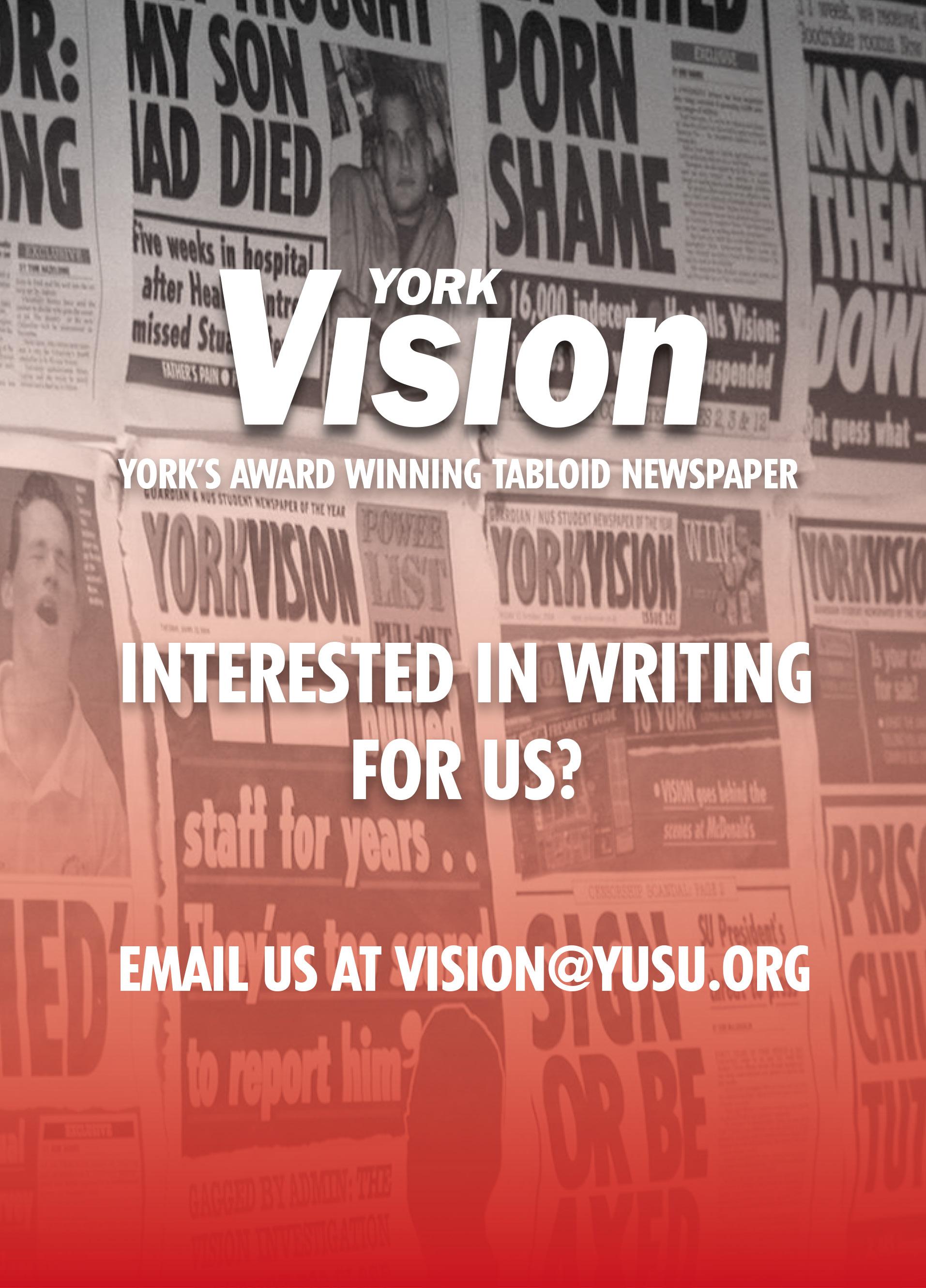
SCENE.
NOSTALGIA
INSIDE THIS ISSUE
Will nostalgic remakes ever run out of steam?
Interview: Theatre is wonderfully ephemeral
Sunshine on Leith: Timeless Nostalgia
Nostalgia, Natsukashi, and University Break-ups
‘NOSTALGIA’
Design by Olivia Stapleton @oliviastapletonart
CONTENTS
Our editors get
nostalgic...
SCENE Editor
Dan Gordon-Potts
Illustrator
Olivia Stapleton
Back Cover Illustrator
Sam Braham
Chief Subeditor Vacant
Subeditors
Philippa Salmon
Jacob Bassford
Ashani Padhye
Katie Preston
Hello everyone! It’s me, again. I’m sad to say that this is my last editors note for SCENE (although it you flick back a couple of pages you’ll see that I’ve taken on a new role as Editor President - Vision you can’t get rid of me that easily).
In my role as SCENE editor I have had the pleasure of working with some incredible writers and providing a creative space for students to express themselves and experiment with their talent. I am proud of the way we have started to promote the artistic talent we have on campus with our SCENE covers and I hope that this is something we can continue.
As editor, I have written on a complete range of topics for SCENE - some of my favourite being how to balance a long distance relationship, information of the local foodbanks in York, and an exploration on whether children are too exposed to gambling. I feel that as a
team we have done well this past year to incorporate some important issues into our Arts and Culture magazine as well as continuing with more light-hearted and entertaining articles.
I would quickly like to thank everyone that has written for SCENE for the past year, you are all incredible and quite literally SCENE wouldn’t exist without you guys! Anyway, guess that is me really done. I should probably hand you over to Dan. Uh oh… only joking, SCENE is in very safe hands.

Greetings! Didn’t see you there, I was too busy crying with intense nostalgia over the end of an era. Sinclair’s SCENE era is at an end. Then again, I guess Emily’s promo tion to Editor-In-Chief of the entire paper isn’t too sad - this also marks an exciting time for Vision - I know she and Kaitlyn will do an great job, and I am excited to be working with
them and the incredible new team.
Anyway, currently Emily has given me an extensive list of tasks, so I am beginning my editing tenure sat in the glorious Vision office on a snowy-now-sunny (?) day with geese quacking outside and a feeling of hunger in my stomach (I have already been here for many hours without realising).
My goal is to make SCENE the place for art and culture, and to build a community of curious minds to get out there, connect with people, and do incredible journalism. I can’t wait. I hope you enjoy this issue, where we explore the theme of NOSTALGIA, marking an end to one era of Vision, and the start of an exciting new one.
Watch this space...
ARTIST SPOTLIGHT: OLIVIA STAPLETON
SCENE is the place for Arts and Culture at the University of York. Olivia Stapleton, a third-year English Literature student and the chosen Illustrator for this print, talks about her artwork...
This piece was created through experimentation with 35mm film photography, before being edited in photoshop to emphasise its texture and contrast. I love how the light leaks have formed different layers that feel transcendent and

natural; the photograph is an abstract representation of a pastoral landscape, featuring a mountain range and a blue sky that dramatically fades into black clouds. The off-centre circle is void-like, appearing surreal and dominant within the composition, acting both as the piece’s focal point and a disruptive force to its overall balanced harmony.
The red halo is reminiscent of the moment that a roll of film overheats, burning from the inside out while it is projected.
Creating art with this media is less familiar to me as an illustrator – however, I’ve been working more recently on photography projects, as accompaniments to my poetry, which I look forward to sharing online and in my zines!
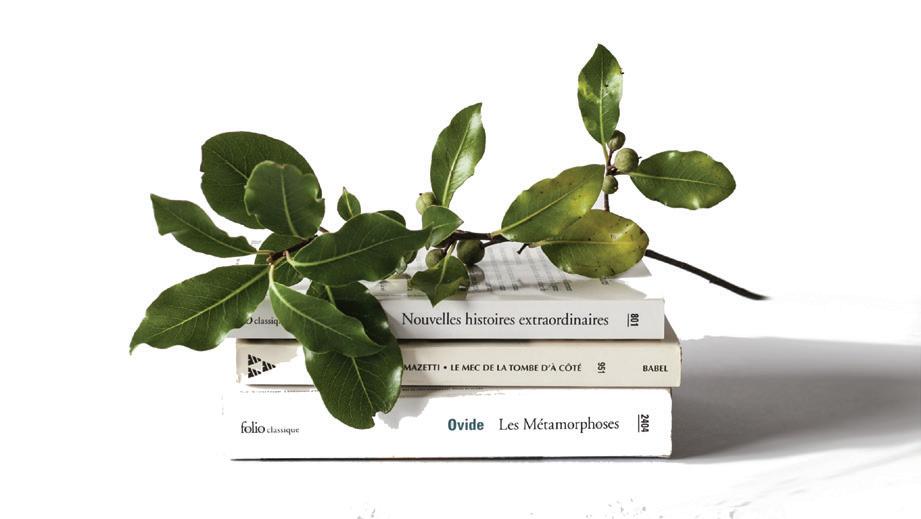
You can find Olivia’s art and more on her Instagram pages. Many thanks also to all the artists that submitted to this issue!
Instagram: @oliviastapletonart
Stage
Editor Kayleigh Wittenbrink

Deputy Editor Vacant
IMAGE: IMDB

Screen
Editor Jed Wagman Deputy Editor Vacant
Music
Editor Alicia Ward
Deputy Editor Vacant
Tech
Editor Vacant
Deputy Editor Vacant
Food & Drink
Editor Navya Verma
Deputy Editor Vacant
Relationships
Editor Otty Allum
Deputy Editor Vacant
Travel
Editor Lizzy Mackay
Deputy Editor Vacant
Books
Editor Kate Shelton

Deputy Editor Vacant
Write for SCENE. scene@yorkvision.co.uk


2
IMAGE: ALEX HOLLAND
NOSTALGIA
SCENE: Our Edition in Images
Emily Sinclair, Editor President, York Vision
4 7 11
Dan Gordon-Potts SCENE Editor
Will Nostalgic Remakes Ever Run
out of Steam?
It seems like every other day a new remake, sequel/prequel or live action is announced by a major studio. Just this year, we can expect at least fifteen films that are either sequels of well known franchises or reboots; a few of the most notable being The Little Mermaid, a new Indiana Jones film and a Hunger Games prequel. Even recently, an announcement has come out stating that there are new Lord of the Rings films on the way.
The biggest question is probably the most obvious, why do these films keep getting made? But also, why do people feel so strongly against them, while still continuing to watch them? All it takes is a simple tweet in response to a new trailer for a reboot, for Twitter to erupt into the same repetitive conversation about why less money is being invested into original stories.
The thing about these types of films is that they’re a distributor’s dream. They’re less of a gamble to put into cinemas, because their success has already been proven before. It’s unlikely for a Jurassic Park movie, for example, to be a complete flop. In fact, Jurassic World: Dominion was one of the highest grossing films of last year. In the current economic state, people are going to the cinema less, as it is a luxury after all, and are therefore less likely to take a ‘risk’ on what they spend their money on. Reboots are reliable, and familiar, regardless of how you feel about them.
Another thing is that people’s nostalgia is laced with gold. There’s a lot less marketing to do upfront if the audience already exists. Then, less money needs to be spent on identifying and targeting the audience since the film is highly anticipated.
The film industry, at the end of the day, is a business. So remakes and sequels with well-known characters and storylines are much less of a box office gamble than ‘original’ stories. With the uncertainty of covid, we’re going to be seeing a lot more of these kinds of movies in the future as the exhibition
and distribution industries get back on their feet.
If you look at box office figures dating back to 2019, the most common theme is that comic book adaptations are the most successful. Studios need to find a way to compete with this genre, while also trying to not be in too much direct competition with each other. This theme is called “market polarisation”, when investors or distributors make a small genre group within the market the centre of their attention, over anything else.

Although these films can feel oversaturated at times, when you look at the IMDB page for upcoming releases, they’re actually quite spread out in an attempt to avoid this feeling. It seems like remakes and reboots are being churned out faster than you can watch all of them, their release dates are carefully managed to ensure they’re not all released at the same time.
The only way for them to stop being made is for us to stop watching them, but we’ll still go see them out of curiosity as to whether the adaptation was successful in our eyes. There are original stories still being made, but they do need significant backing and trust to get off of the ground. This year we had M3GAN and Pearl, two new horror icons to fit into the canon alongside the classics. Along with Cocaine Bear and Pixar’s Elemental later on in the year. And let’s also not forget about Aftersun’s impressive box office performance.
Like everything, it requires a careful balance. A balance between old and new, as much as blockbuster and independent. Neither are going to entirely erase the other, because people will always have a preference over what they prefer to watch. The industry is an ecosystem with different complex strands and demographics. Perhaps nostalgia does have the power to wear thin on certain things. Maybe people getting sick of the Marvel Disney+ shows is an example, but it will not fade entirely. We all need a bit of escapism now and then, or just a reminder of
Feeling old? Here are six films that came out ten years ago:
1. About Time, directed by Richard Curtis, starring Domhnall Gleeson, Rachel McAdams, and Bill Nighy.
2. Gravity, directed by Alfonso Cuarón, starring Sandra Bullock and George Clooney.
3. The Conjuring, directed by James Wan, starring Patrick Wilson and Vera Farmiga.
4. The Book Thief, directed by Brian Percival, starring Geoffrey Rush, Emily Watson, and Sophie Nélisse.
5. The Hunger Games: Catching Fire, directed by Francis Lawrence, starring Jennifer Lawrence, Josh Hutcherson and Liam Hemsworth.
6. Frozen, directed by Jennifer Lee and Chris Buck, starring Idina Menzel and Kristen Bell.
Feel old yet?!
5 Films That Could Be Drastically Improved with Long Boi
With over 50k Instagram followers to his name, it’s about time that York’s favourite duck had his own movie.

He’s already got the merchandise and cuddly toys to go with it! But until Disney snap up the movie rights for an animated Long Boi film (and then probably a live action remake in 20 years’ time), we’ll have to settle for our own imagination. I’ve rounded up some of the best films that could be improved by replacing the main character with Long Boi.
1. Knives Out
As much as everyone loves Daniel Craig’s ridiculous southern drawl, picture the scene; you’ve got Long Boi all dressed up quacking away at a room full of suspects ready to solve a murder. Benoit Blanc who?
2. Top Gun
There’s only one thing that peo ple watch Top Gun for. That is of course the incredible flying scene. Just picture the uni’s favourite duck in the cockpit of a fighter jet. Oh, and he could also join in on the topless beach volleyball too.
3. The Truman Show
Imagine a world where everyone around him knows who he is, and everybody wants to watch him 24/7 but he’s got no idea what’s really going on- actually that one’s quite close to reality and a normal day for the duck. Long Boi could give Jim Carrey a run for his money though.


Baby Driver is probably the only film on this list where the main character really does need replacing. And who better to replace Ansel Elgort with than Long Boi. In fact, Fancy Boi can even replace Kevin Spacey in the film too. I don’t know if Long Boi has a driving licence but I’m sure he could learn.

5.
Long Boi could be one of cinema’s greatest action heroes if only we gave him the chance. It’s Christmas Eve and hardened NYPD detective Long Boi Clane arrives in LA to try and reconcile with his estranged wife when suddenly he has to take on a team of German terrorists. Now that’s a film I would pay good money to see.
SCREEN EDITOR JED WAGMAN SCREEN scene@yorkvision.co.uk
Rosie Bailey
4. Baby Driver
Die Hard
Jed Wagman
3
@YVScreen
STAGE
1. Hello! First of all, would you like to introduce yourself? What is your name and your recent role within the G&S society?
Hello! I’m Pip, I’m a second-year English and Related Literature student, and I was the Musical Director for the university Gilbert and Sullivan Society’s production of The Gondoliers that ran earlier in March.


2. How are you? After such a successful run last week, I can imagine you are reeling from it all. On reflection, how do you think Gondoliers went?
Reeling would be the right word for it! I can’t believe that it was only last week that we were performing, it already feels like such a long time ago. I’m keeping pretty busy with uni work thankfully so the post-show blues isn’t hitting too hard though. Reflecting on the run, I’m absolutely thrilled with the show we produced; everyone worked so incredibly hard and you could really see that in the quality of the performance demonstrated each night.
3. More specifically then, as a Musical Director, what did you do? For those not in the theatre world it just sounds like a fancy term but what actually was your role?


For people who aren’t familiar with G&S, they wrote comic operas during the Victorian period; I often describe them as early musical theatre. The music can be quite technically demanding of both the singers and the orchestra, but the operettas are fantastically funny and full of political satire that is often still relevant today. As Musical Director, I was in charge of everything related
to the music in the opera: I taught all the numbers in the show to the cast, both solo parts and chorus roles; I was responsible for sourcing and rehearsing the musicians who formed the orchestra that accompanied us; and I also conducted the show every night! It was a huge role and a lot of responsibility, but it was the most incredible experience.
4. As Musical Director you obviously play a pivotal role in creating the show. How would you describe the process of getting from just an idea to a fully-fledged performance? What have been some of your ups and downs both as a cast and more personally throughout the process?
Getting the show from a loose concept to an onstage reality was a long and quite daunting process! Vision-wise, it was all down to our fantastic director Amber Medway, who was in charge of the show’s overall aesthetic and also any dialogue and characterisation; I just had to ensure that what I was working on with the singers fitted with her vision. Despite only a few members of the cast being familiar with sheet music notation, the whole group worked fantastically hard to learn their music in whichever way worked for them, and it led to me mostly teaching by ear - not a short job when there are four different lines in most of the numbers! I was so thrilled when several of the cast told me that they hadn’t found unfamiliarity with sheet music to be an obstacle to learning their parts of the show. Personally, I’d say that the responsibility has been the biggest challenge - but also the biggest reward.
This role has been immensely challenging and humbling for me, but also one of the most fulfilling and rewarding things I’ve ever done. Every rehearsal pushed my understanding of my own capabilities, and I can’t believe that I was able not only to teach an entire opera, but also to rehearse and conduct an orchestra!
5. Finally then, are you already feeling nostalgia towards Gondoliers? What place does it have in your life and why do you think theatre in general has the ability to be so nostalgic?
I definitely already miss the show! Especially in prod week, the week where you’re working in the theatre and preparing for opening night, the atmosphere within the cast and crew is just electric. It’s such a unique and incredible environment, and the adrenaline that it takes to get through the performances can often leave you feeling quite empty when the run is over, leading to post-show blues; I know a
lot of us in the cast, crew and orchestra have felt that this week! The Gondoliers has an immensely special place in my heart as the show that made me an MD and taught me so many things about myself, and also gave me a way to connect with my history, as my family have been involved in G&S productions basically since they were first performed! Especially with something like G&S that’s been around for such a long time, creating a new piece of theatre with it is definitely a nostalgic experience; we’re so lucky to be able to reach into the past and connect with all those who have put their own unique spin on this show before us. At the same time, theatre is wonderfully ephemeral; each performance was an entity entirely its own, never quite able to be replicated. Looking back on that is a unique but very special kind of nostalgia, recalling a time of immense joy that can never be recreated but is all the more rewarding in the moment for that very immediacy.
PHOTOS: KIRKPATRICK PHOTOGRAPHY
Charming and wonderfully conducted orchestration accompanied UoY’s Gilbert & Sullivan’s production of The Gondoliers at Joseph Rowntree Theatre in the classic Victorian comedy-opera, spoofing aristocracy and continental Europeans. It was everything a Gilbert & Sullivan production should be, wonderful costumes, well-timed humour and, of course, opera singing.
The premise consists of two Gondoliers trying to figure out who is the son of the deceased King of the fictional Barataria, who was deposed for his
conversion to Wesleyan Methodist (as someone from a Methodist background myself, I found that quite funny).
To further complicate matters, the son was betrothed as a baby to the daughter of the penniless Duke of Plaza-Toro, and the two men are already married! What follows is two hours of delightful operatic chaos.

Katie Leckey as the Duchess of Plaza-Toro was by far the production’s tour de force, her acting, comedic timing and mannerisms were a powerful presence on stage. The chemistry between her and Eli Evdokimova (playing the Duke)
@YorkVision
was great as well, adding to the comedy.
The production was full of great duo acts, with Ben Long and Wilf Tomlinson making an excellent pair of Gondoliers, complimented really well by Grace Stannard and Molly Raine as their wives, Gianetta and Tessa.
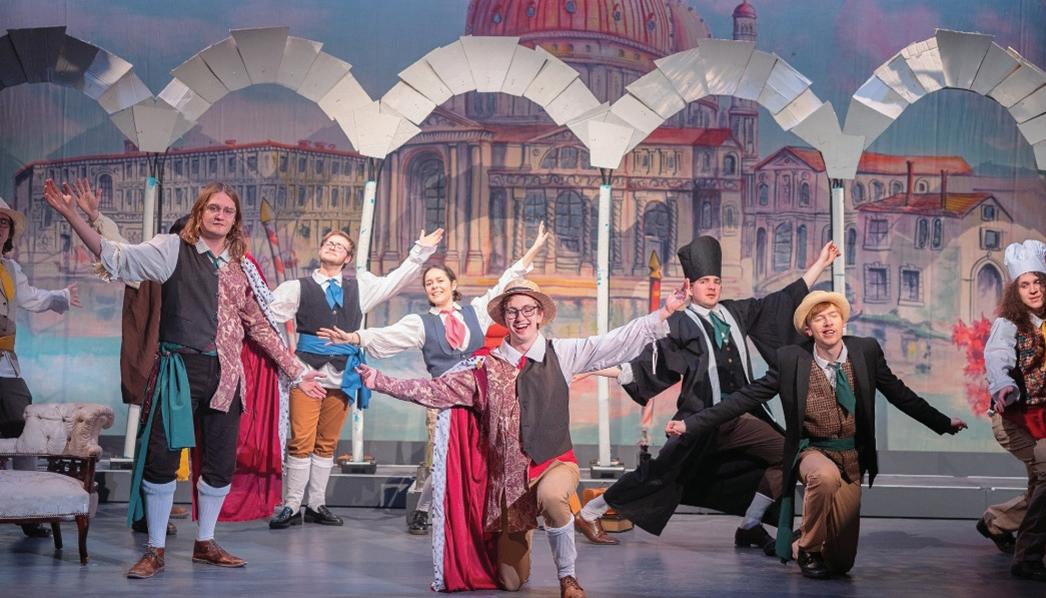
A further word to Thomas Weddell, their performance as the Grand Inquisitor was a great spoof and another highlight.
One of the criticisms I would say is that some of the dancing and
harmonies were quite iffy, as well as the projection of the singing at points.
Nonetheless, it was an impressive feat for the cast to perform such a challenging show, it was clear to the audience this was a show that the cast and crew put immense effort into and had a great time performing it!
KIRKPATRICK PHOTOGRAPHY TOP IMAGE: ALIX LUCAS
Theatre is wonderfully ephemeral: Interview with Musical Director Philippa Salmon Emily Sinclair 4
Review: Classic Silly Goofiness in
The director, Amber Medway, and Musical Director, Philippa Salmon, should be really proud of their joint effort to put on a thoroughly enjoyable show.
Jacob Bassford
Kayleigh WIttenbrink
Review: Northern Ballet’s The Great Gatsby, Leeds Grand Theatre
Set in the exuberance of 1920s America, The Northern Ballet’s production of The Great Gatsby is an experience for the senses, beautifully encapsulating the highs and lows of the roaring twenties. The Northern Ballet’s performance began by introducing the audience abstractly to the different characters and their characteristics, such as Jordan’s signature golf swing, before it dove into the plot.
The overarching story follows the reunion of Daisy Buchanan with her past lover Jay Gatsby, brought back together through her cousin Nick Carraway. It also includes sub plots such as Nick going to New York with Tom and his mistress Myrtle, being introduced to Myrtle and her husband in the Valley of Ashes and Nick’s romance with Jordan Baker. One thing that was not surprisingly lost in the Northern Ballet’s reimagination was the perspective of the story coming from Nick, a famously unreliable narrator,
however, this was not detrimental to the plot, it just resulted in a more omniscient perspective.
For anyone who has read The Great Gatsby, they will know that the story centres around the theme of desire and longing, especially that of Jay Gatsby and when it came to showing this the Northern Ballet definitely did not disappoint. His scenes on the pier with his arms outstretched looking into the distance and the repetitive flashbacks to young Gatsby were definitely key in reinforcing his character’s tendency to dwell on the past and his pining for Daisy. However I do wonder if the symbolism of the green light and the position of Gatsby’s house being across the river from the Buchanan’s was necessarily clear to the audience.
David Nixon’s choreography as well as showing the light and dark of the plot, also seamlessly integrated some amazing characterisation. The audience could clearly see Nick’s nerves and dubious position within the upper class as well as
Jordan Baker’s boyish and “new woman” style. The choreography also included a great mix of classical movement intertwined with those reminiscent of popular dance styles of the 1920s ranging from the Charleston to the Tango.
Another element that I was particularly fond of was the way in which Nixon presented relationships and their different dynamics. For example between Act I and II, we see Daisy and Jay’s relationship shift from an uneasy and uncertain reunion, to one full of excitement and passion struggling to hide their love from Tom.
I also loved the representation of the past made clear through a combination of music, lighting and dancers and I was particularly fond of the way in which it was shown to haunt Daisy and Jays present relationship, especially in the opening scene of Act II.
As someone who has read and in fact previously studied The Great Gatsby, I thoroughly enjoyed experiencing the way in which the ballet chose to represent
themes, relationships and seeing the areas which they chose to focus on. However, I would recommend that anyone who hasn’t read The Great Gatsby or needs a refresher, picks up a programme which includes a lovely succinct summary of each scene.
I would highly recommend trying to come and see this ballet if you’re a lover of ballet or a complete novice. This was my first time ever attending and it’s definitely given me a taste for it.
Sunshine On Leith: Scottish Nostalgia
This term CHMS returned to the Joseph Rowntree Theatre with an enlightened tale of love, growth and companionship, as they took to the stage in ‘Sunshine On Leith’.
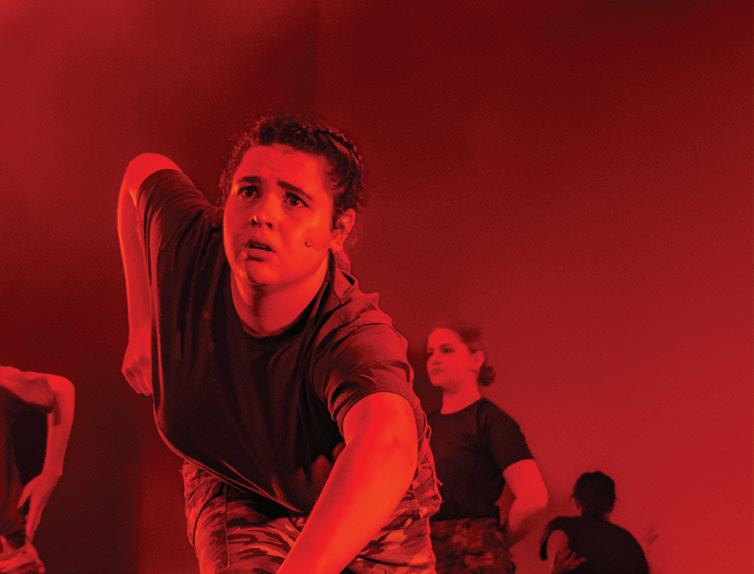
Bringing the quaint Scottish musical to the York stage, the energetic cast sung their way through versions of the Proclaimers top songs, including “I’m On My Way”, “Over and Done With”, “Let’s Get Married” and of course “I’m Gonna Be (500 Miles).”
Bursting open with a storm of gunshots and closing on a rainbow plateau of step-in-time ensemble energy, Sunshine On Life walks 500 miles of musical heart.
With timeless notes of nostalgia, growth and familial purpose, this is a story of coming of age for all ages. The musical lovingly strides through key themes of friendship, young and old love, and the endless charm of the Scottish, tackling its
lore with humour and heart.
As such the musical needs a focused team of cast and crew to deliver the touching ideals the story deserves. And that is exactly what CHMS brings.
Romily Swingler’s direction is planned and inviting, with appealing staging bringing the streets of Edinburgh lovingly to life. The powerful lighting and staging of the opening wartorn scene is particularly engaging, an atmosphere she continues throughout ever subsequent setting. This focused direction allows for some stellar ensemble characterisation to shine, which, when placed alongside a stunning skyline backdrop, transports audiences right into the Scottish capital city. The transformative accents of the cast are the cherry on top of this theatrical transportation, even if I’m not the best judge of the Scottish prose.
Nathan Livington’s reliable choreography draws on obligatory folk numbers and energetic bar scenes, closing out the night on an contagious clap-along version of “500 miles” . Where the choreography really excels, however, is in the delicate partner numbers which decorate the story’s more heartfelt moments..
Waltzes and contemporary duets often cross the stage in gorgeous representations of heartache and companionship.
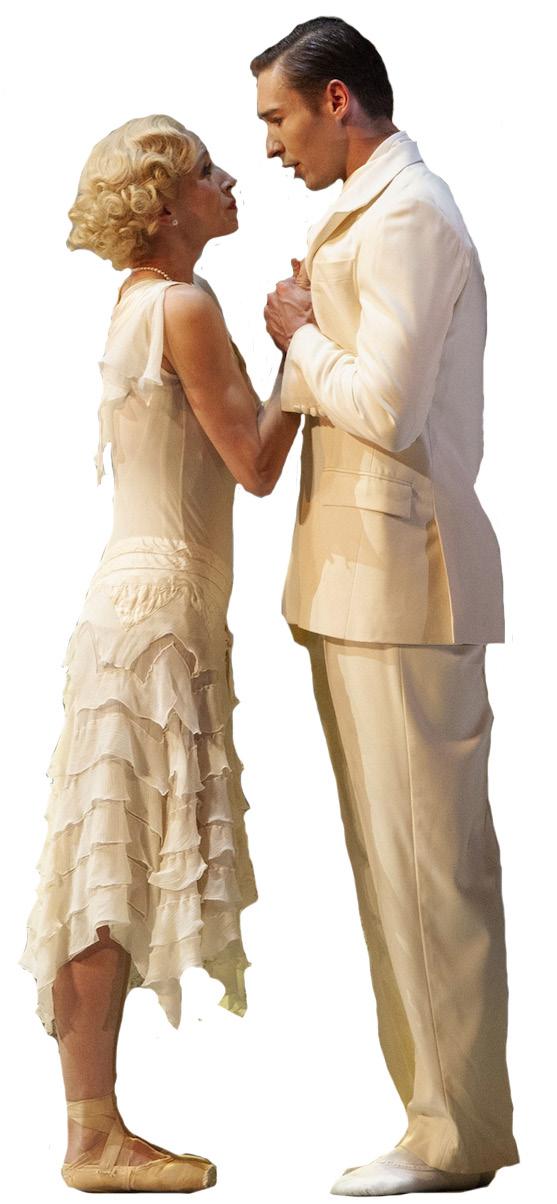
This was particularly resonant in the titular number ‘Sunshine On Leith’, where
a blend of intricate dance and tender vocals stunned audiences into sobs; a clear standout of the night. The pairing of Ellie Carrier and Ollie Kingston as the younger Jean and Rab offered beautifully stylised dances as they personify a flow of love through the ages, even at the couple’s darkest moments. But this pair weren’t the only ensemble standouts. Ollie’s alternate appearance as a barman offered much Scottish pub hilarity, Ella Coldron’s turn as Jean’s friend had care and a killer voice, and Josh Liew’s acoustic quitar solo shone like the stars lighting his scene.
The ensemble numbers were generally crammed with humour and merriment, where my absolute favourite was a scene in a call centre which allowed a hilarious and informative exploration of accents.
Leading this engaging ensemble were a family of delightful performers. Will Parsons and Will Harvery make for an infectious duo of best friends Davy and Ally as they showed off cohesive wit and a surprisingly perfect blend of vocals.
Darcey Chambers and Kayla Vicente shine as their respective partners, Liz and Yvonne, boasting lovely vocals, a strong friendship and a thoughtful array of emotional moments. This quartet really exemplifies the honest and realistic struggles of young love, themes that resonant most impressively in an eloquent rendition of “Make My Heart Heart Fly.”
Parental figures Rab and Jean are maturely performed by Vincent Klein and Lotty Farmer, who navigate repsective fatherly guidance and motherly heartache alongside complex marital emotions. Vincent’s heart driven protrayal never falters, while Lotty’s impressive vocals and steadfast emotional core fulfill multiple standout moments. Her soft articulation of the titular ‘Sunshine on Leith’ was particularly spell-binding as Jean tackles a difficult conflict between commited love and feelings of betrayal.
While the production did face some oddities in the microphone levels and the scene transitions, it’s never enough to distract from what is a well handled tale of love and Scottish charm. Not every moment gelled with the audience first time, but the ones that do are deeply resonant and impressively orchestrated by the student lead team. The producation had certainly found their groove by the end of the performance and with such strong direction and focused choreography, its clear that CHMS once again achieved a touching and enjoyable musical by utilising the best and brightest of its talented creative team and cast.
While it may not hit every note every time, when it did this production lit up with exuberant and ever-inspiring sunshine on Leith!
5
STAGE EDITOR
scene@yorkvision.co.uk
Jemima Holliday
Kaitlyn Beattie-Zarb
PHOTO: CENTRAL HALLL MUSICAL SOCIETY
PHOTO: CAROLINE HOLDEN
MUSIC

Ten songs that are ten years old...to make you feel old Katie Preston

It’s 2023, and I’m already terrified that I’ve entered my second decade of life. Reminiscing on long car rides as a kid and trips to the shopping centre, I thought to myself - I wonder what songs are turning ten this year? And the results shocked me, both in terms of how many years I have aged, but also for how much music slapped ten years ago. So here are my top ten songs that came out in 2013, yikes.
Clarity - Zedd ft. Foxes
This song is here on a technicality. The music video was released in January 2013, but it was technically released in November 2012, but this song is too much of a gay anthem to not include on this list. I lived and breathed this song. I still listen to it and scream-sing it in the shower. It’s the best song Zedd has ever produced, and it started me down a minor Foxes rabbit hole (fox hole?).
Applause - Lady Gaga
Controversial yet brave, but ARTPOP is a phenomenal album, and this iconic song, and its even more iconic music video, is a key part of 2013 for me. I remember when this song came out. For the non-little monsters out there, ARTPOP is a cult classic fans - it’s one of my favourite albums ever - this title track is peak 2010s Gaga.
Young Volcanoes - Fall Out Boy
I’m biased here, because Fall Out Boy is one of my favourite bands of all time and I’m VERY excited that I got tickets to see them in October, but this album was the comeback for this band. After a hiatus for five whole years, this album was a pinnacle movement in alternative/emo culture. It’s a beautiful coming of age song, and fully deserves a place both in FOB’s and 2013’s top spots.
Blurred Lines - Robin Thicke ft. T.I. and Pharrell
This song, for better or for worse, directly contributed to my sexuality crisis a few years after its release. If you’re familiar with the two music videos, you will know why. It’s just such a groovy song. Do I want it? I don’t know. What does rhyme with hug me? The song has lots of criticism for depicting a forceful and quite creepy narrative, which I do wholeheartedly agree with, but it was definitely an iconic song of the 2010s, and that one time I heard it in Jalou I did go feral.
Mirrors - Justin Timberlake
For some unknown reason, I romanticised the idea of Justin Timberlake as a child. I was obsessed with that man, listening to his 2013 album ‘The 20/20 Experience’ on my god-awful Samsung Galaxy Ace 2. I loved this song, staring blankly out the window on long car rides at the age of eleven, and to this
Can I be a ‘Better Man’?
day I can do a pretty good job at karaoking this iconic track.
Just Give Me A Reason - P!NK ft. Nate Ruess
P!NK is such an iconic 2010s singer, giving us banger after banger, and this song is no different. A brilliant song to scream-sing in the car, it was miles different from P!NK’s previous singles of ‘So What’ and ‘Get the Party Started’. The music video is another one that remains stark in my mind from 2013, and this song started my distant love affair with P!NK. It is also included on my ‘Songs I think I can sing’ playlist, so do with that what you will.
Stay - Rihanna ft. Mikky Ekko
Rihanna has a special place in my heart. I did a choreographed dance to her song ‘Umbrella’, that my father had illegally burnt onto a CD, to my Year One class. But to this day, my favourite Rihanna song will always be ‘Stay’. It’s vulnerable, it’s emotive, and leaps and bounds different from her other singles. Mikky Ekko is also an incredibly underrated artist, and the blending of the two rivals ‘Just Give Me A Reason’ for heartbreaking songs to sing along to alone in your house.
Heart Attack - Demi Lovato PUTTING MY DEFENCES UP. This song is the peak of the 2010s for me. Heart Attack is a song that I would put on when I was unreasonably angry, and as such I still know most of the words today, but there’s nothing better than blasting this song through my Poundland headphones on the way to a twelve hour bar shift.
Somewhere Only We Know - Lily Allen
My favourite of the John Lewis Christmas adverts, Lily Allen’s cover of ‘Somewhere Only We Know’ by Keane was drastically different from Allen’s hits, depicting a more emotional performance compared to ‘Smile’ and ‘Not Fair’. Beautifully matching the 2D animation of the advert, Lily Allen’s emotive cover helps to further Disney-fi the advert, bringing the spirit of 2013 Christmas flooding back.
One Way or Another (Teenage Kicks) - One Direction
This is the most iconic thing to ever happen on a BBC fundraising programme. This music video for Red Nose Day was iconic. Why was David Cameron there? I don’t know, but what I do know is that this is unironically one of the best cover songs of all time.
The Perspective of Being a Male Swiftie Jacob Bassford
Spotify Wrapped hit its users once again in December 2022 with its cruel exposure of cringe and crazy stuff we all listened to in dealing with another crazy year. Its verdict declared that my top artist was Taylor Swift and my fifth most-played song was Better Man (Taylor’s Version) (From the Vault). I first came across this song on TikTok (which I no longer have downloaded, I am pleased to say) early in 2022 whilst dealing with the second-term University strikes.
The song was originally written by Taylor for 2012 Album ‘Red’, but it did not make the cut and the artist gave the song to country band Little Big Town for their 2017 studio album, ‘The Breaker’. When Taylor re-released ‘Red’ in 2021 as part of the well-known ongoing dispute between her and Big Machine Records over ownership rights, she recorded her own version of Better Man to include in the re-release, and personally it is one of my favourite songs by her.

The song describes the narrator talking about dealing
with a relationship break-up, about missing a man and knowing that if he had been “better”, she would have not ended things with him. This song is relatable to anybody in any kind of relationship, who dealt with the pain of knowing they made the right decision despite loving/really liking that person. Taylor knows better than anyone how to convey multiple and complex layers of heartbreak. This song may not be the most well-known amongst the casual music listeners, but to use Arthur Miller’s words in his 2004 introduction to Tennessee Williams’ A Streetcar Named Desire, it “is a cry of pain”.
However, this song has always resonated with me in a slightly different way than perhaps what Taylor intended. I first started listening to this song when I was admittedly going through a bit of a rough patch. To be honest, for either right or wrong reasons, I often listen to Taylor when I’m not in a particularly brilliant mood. It makes me think of past experiences, not even necessarily romance-related events either, just times where I was in the wrong, where I wasn’t “a better man”. Whilst it can be often unhelpful to dwell
on events such as this, for me this song demonstrates the power of music to make us think and feel in ways that the artist didn’t necessarily intend, giving listeners agency in experiencing music in its complex, fluid and extensive explorations of emotions. This doesn’t just apply to sad songs for me either. Despite being a straight man, I love Rihanna’s Only Girl in the World, not only because it’s a party bop but because I love the idea of a woman actually feeling like the titular lyrics because of me, again, slightly cringe I know.
Maybe my perhaps slightly unusual resonance with Better Man highlights what I perceive to be both an oft-juxtaposition, and also a rarity, of being a straight cis-man who is a Swiftie. Is it because I am a hopeless romantic or an overthinker who dwells too heavily on his past mistakes? It’s probably both. Nonetheless, the song, like so many of Taylor’s hits, is a powerful reminder of the pain and hurt that comes from failed relationships which can resonate with anyone, whether they have been in that situation or not. And it reminds me that Taylor is an artist with widerange appeal, even sometimes for us men.
MUSIC EDITOR Alicia Ward @YorkVisionBooks @YorkVisionScene
@YorkVision scene@yorkvision.co.uk 6
RELATIONSHIPS 7 Relationships EDITOR OTTY ALLUM
UNIVERSITY IS A time in your life when you begin to look forward. You’re moving away from your home and your family to live independently for the first time, with the gates of adulthood opening in front of you. Your horizons broaden; you start to see, somewhere amid the haze of deadlines, the direction your life might take after graduation. Even when the postgraduate future feels too far-off and frightening, the deadline system keeps your eyes firmly forward, with little time for dwelling on the past. This can be saddening, letting your childhood blur gently into the mists of memory, but it can also be helpful if there are things you might want to leave in the past.
It is a truth universally acknowledged that sometimes relationships have to end. It is less widely recognised that the reasons for this are not always bad, and that this can sometimes create much more complex and difficult emotions in the aftermath. In the summer between my first and second year, my long-term relationship ended. It was a mutual decision: there was no bad blood, we had simply grown apart as people. But suddenly, I found myself left with the strange combination of a badly broken heart that held mostly good memories of our time together. How was I supposed to reconcile these?
be a tough one to grapple with when you’re dealing with a broken heart. It’s easy to feel like reflecting on those good times is taboo, especially in a society that prioritises ‘putting yourself first’ in the aftermath of a breakup. It’s hard to know whether happy memories are still allowed to be happy, or whether the end of a relationship means you have to disregard every positive moment of it. Ironically, it was my ex who introduced me to the Japanese concept of natsukashii, a form of positive nostalgia that “indicates joy and gratitude for the past rather than a desire to return to it”, according to journalist Erika Hobart in her February 2020 BBC Travel article. For those going through breakups, this is a useful way of thinking about the inevitable process of reflection on the long, slow road to healing.
The end of a relationship doesn’t automatically negate all the positive memories made during it but, through engaging with the concept of natsukashii, it is possible to reflect on the happiness of your time with your ex without wanting to relive it. Indulging in this kind of nostalgia seems to me to be a key step in the journey of healing from the end of a relationship; an acknowledgement that this was a good, but now closed, chapter of your life.
friendships I’ve formed at uni. Making new memories with the songs and spaces previously associated with a lost relationship, although it doesn’t negate the old memories, can help to write them into a hazy past, to be reflected on with goodwill but no desire to repeat it. So dance around your kitchen to that song that makes you happy. Take your friends to that cafe that you love. Rewatch that TV show with your housemates. And someday in that distant, postgraduate future, you’ll be grateful for the way university made you look forward, and you’ll see that the gap that feels so empty right now was an opening to let new light into your life.
“Someday in that distant, postgraduate future, you’ll be grateful for the way university made you look forward, and you’ll see that the gap that feels so empty right now was an opening to let new light into your life.”
Regardless of how or why a relationship ended, nostalgia for the good times you shared with a person you cared about is a totally normal feeling. However, it can
However, nostalgia and memory can also be sources of pain after a breakup. Certain places, songs and activities might inevitably become bittersweet. These reflections, although harder, are also necessary; it can be difficult to come to terms with what may feel like a gap in your life. However, I’ve found healing in rethinking the nature of that gap, choosing to see it not as the absence of someone or something, but an open space for new things and people to come into my life. I’ve used it as inspiration to pick up new hobbies (hello, crochet), to engage in largescale projects, such as musical directing an opera with the G&S society on campus, and to expand the network of

What Sex and the City Taught Us About Love Marti Stelling
Airing between 1998 and 2004, Sex and the City has had a huge influence on pop-culture to this day.
From popularising the cosmopolitan to causing sales of Jimmy Choos to skyrocket, Sex and the City is arguably as influential today as it has ever been. With the second season of And Just Like That (the Sex and the City revival) set to hit our screens in summer, I decided to dust off my boxset and do some revision. Let me take you on a trip down memory lane of some of the most influential lessons the show taught us… (a cigarette and cosmo in hand are mandatory!)
Being single doesn’t mean being alone
Throughout the show, Carrie, Charlotte, Miranda, and Samantha navigate a series of relationships, heartbreak, and singleness. The thing that remains constant for them is their friendship with each other.
You’re going to go on some BAD dates
This show is littered with dates that end horribly. Theres’s men who fist fight, get too drunk, have overly involved mothers… If SATC teaches us anything, it’s to trust in the process.
Happily ever after does exist
Despite everything these women went through, they all found their happily ever after- whatever that meant for them.
If you love them, you can overcome it
Just look at Charlotte who changed religion to be with Harry, or Carrie and Big who overcame numerous challenges but somehow figured it out in the end!
Wear the dress, make the first move
The main characters of SATC were bold. Whether that be in terms of fashion or dating, they were not afraid to do things that made them happy on their own terms.
Sex is not shameful
Revolutionary for its time, this show celebrates female sexuality in a way that still holds up today!
Communication is key
This is a lesson we can all take from Samantha. She was never afraid to speak up and stand her ground when something was bothering her- no matter the situation.
Heartbreak is very painful- and very real
Watching Big leave Carrie at the altar is one of the most heart-breaking moments of SATC. The show is
filled with lots of relationship ups and downs, which is the reality of being in love with someone.
Body count doesn’t matter
Not at all. Google Samantha’s if you need some reassurance.
Variety is the spice of life
The friends in SATC could not be any more different in almost every way imaginable, but that is what makes their conversations so interesting!
Have sex like a man
Samantha said it, not me!
Be choosey!
The girls in SATC never settled for anything less than what they deserved, whether that be a wardrobe or a man.
Sometimes, shoes are your one true love
True, Carrie must have been living in her overdraft, but her feet looked incredible whilst doing it! Whether you’re a single girl in the city or in a long-term relationship, watching Carrie &co may be more impactful on your love life than you realise!
IMAGE: FLICKR
“It is a truth universally acknowledged that sometimes relationships have to end. It is less widely recognised that the reasons for this are not always bad...”
Nostalgia, Natsukashii, and University Break-ups Philippa Salmon @YorkVision scene@yorkvision.co.uk
TECH
Here are some games from my childhood (and hopefully at least some of yours) which make for good study soundtracks. A lot of the soundtracks were meant to be in the background whilst you went and explored the in-game environment and so are well suited to the task of background music to accompany you whilst you study. And of course, if you played any of these games as a child you will get that warm fuzzy feeling of nostalgia as a bonus.
Minecraft:
Starting off with a fairly simple one (and one I’d be willing to admit that at least some people reading have had in the background whilst studying before) is the Minecraft soundtrack. The vast majority of the melodies are very calm and almost uniquely good for settling into the background whilst you get other tasks done. Although it can definitely be an obvious choice, and perhaps overplayed by some people, it
is worth a go.
Super Mario Galaxy:
Now to the soundtrack from a game that was a very big part of my childhood, a game about the well known Italian plumber and his adventures through the stars to save Princess Peach from Bowser etc etc. Moving on from the plot, the soundtrack is fundamentally what makes the game as special as it is. Particularly in the sections of the game that take place on Rosalina’s space station, the calm and wistful tones make for a beautiful setting. But more importantly for this article, there is enough calm music in the soundtrack to last you at least an hour of studying if not more.
Terraria:
I remember playing this game a lot, especially when I was in my later primary school years, exploring caves, fighting off the Eye of Cthulhu and trading with NPCs. Compared with the games listed above, and particularly with Minecraft, these are more tense tunes but there
Playstation VR2:
What’s so great about it?

The Playstation VR2 for the PS5 came out this February, so lets talk about it.
8 Matt Davis
are plenty of playlists that you can listen to without them. As another sandbox game a lot of the music is designed to accompany you whilst you build a house or explore a cave, so why not have it accompany you whilst you get a bit of reading done?
Pokemon:
Pokemon is one of a few genius game franchises that has found a formula that worked and has stuck to it time after time. This means that a whole generation of people can feel nostalgic to at least one of the games and most likely more than one (and who could forget the Pokemon GO summer of 2016). In terms of its effectiveness as background music, it can absolutely work very well. Although it is another one to be wary of what tracks end up on the playlist because some of the more intense fight-based tracks might be a little distracting.
Spore:
We’re getting a little niche here largely because I haven’t played ani-
Katie Preston
which is great for gamer immersion.
The PS VR2 also has come leaps and bounds ahead of its predocesser in terms of accessibility. Now including an interpupillary distance (IPD) adjustment feature, meaning that players can adjust the headset for optimum comfort and image quality, reinforced by Sony finally using industry-standard Fresnel lenses.
The biggest pro of the new PlayStation VR2, I would argue, is the eye-tracking. Human eyes can only see in fine detail in a central region called the fovea, meaning that rendering scenes in ultra high detail in someone’s peripheral vision, for example, is a complete waste of time and money. Eye-tracking thus
allows for something known as ‘foveated rendering’ as it allows for the console to track exactly where the user is looking and render ultra detailed frames in focus and less detailed frames in the background, meaning games can look more detailed whilst using less computing power - how cool is that?!

However, a big issue for consoles these days is a lack of backward compatibility, which in this case means that the VR2 can only be used on the PS5, meaning if you want to update your VR kit, you have to buy an entirely new console. This is a marketing technique riddled with capitalistic intent, and is the case for basically any consoles.
mal crossing or The Sims but would like to give this game’s soundtrack a special mention anyway. I have great memories of exploring the waters as a cell, adapting into an animal and then much later exploring the Universe. Onto the soundtrack - like a lot of natural and space based games it is very peaceful and I would happily study with it in the background, although I do understand lots of people wouldn’t have the same emotional connection to the music as I do.
These are five games which I personally have childhood links to that I think make for good studying music. But of course there are many more out there to choose from, from games you have a closer connection with.
Similarly, the PSVR2 has approximately four times the pixel count of its predecessor, meaning the images inside the headset should look about four times sharper, however Sony has quoted the field-of-view of the PSVR2 at 110°, only ten degrees more than the PSVR1. This basically means that whilst there are more individual pixels, they’re stretched over a wider area, so graphically there’s really not the huge improvement that the pixel increase would imply.
That’s an incredibly brief overview, but with VR technology rapidly advancing, is the £529.99 price point worth it?
@YorkVision
Childhood Video Game Soundtracks and Songs to Study to... scene@yorkvision.co.uk
The VR2 has been majorly praised on its upgrades from the previous model. Unlike the first generation PSVR, the VR2 tracks movements via four cameras mounted on the headset itself, meaning that there is a far greater accuracy than the original VR which tracked movements by an external camera. Furthermore, the VR2 has allowed for greater quality of brightness, becoming the first commercially available VR headset that launches with high-dynamic range display, meaning that gameplay can include much more life-like lighting
FOOD
The Nostalgia of Discontinued Sweets Katie Preston

One of the things I am most nostalgic about is the plethora of UK sweets that have been discontinued since my childhood.
Whilst it’s very cliche to say that ‘kids these days don’t have it as good as us’, I do legitimately believe that that’s true when it comes to sweet treats. Whether that be ice cream or chocolate, gummies or wearable sweets - remember that!? - the early 2000s was a utopic scene of non-savory goods.
We all remember when Jamie Oliver stepped in and removed all the pain au chocolat from our schools, right? Maybe it’s just me, but sometimes I find myself oddly reminiscing on just how good the sweets of my childhood were, and not just in terms of the prices.
So, fitting to SCENE’s theme of nostalgia, I’ve listed my top five favourite discontinued sweets that I yearn to find on our supermarket shelves.
White Maltesers
This one is actually really upsetting. I legitimately cried when I discovered that White Maltesers no longer existed. For years, I thought that I just couldn’t
find them, or that they’d been demoted to the seasonal range of snacks - grr Frosty Fancies! - but no, the superior version of Maltesers no longer exists in the UK. I remember coming back from my swimming physiotherapy sessions with a packet of White Maltesers from the vending machine, sitting proudly in the car as I managed to swim a length of the pool for the first time. Nostalgic and legitimately saddening, I will never recover from the White Maltesers-shaped void in my soul.
Olive Oil in Dan Gordon-Potts
If you haven’t heard the latest news, Starbucks is hoping to tempt you back to its coffee shops later this year with a new addition to its (already extremely extensive) range. That addition is...Olive oil?
The ‘Oleato’ range will contain coffee, mixed (or as they say ‘infused’) with olive oil. Yes, you read correctly!
According to Howard Schultz, the (soon to step down) chief exec of the global coffee chain, it has a “unique flavour and texture” and has “an unexpected, velvety, buttery flavour that [enhances] the coffee and lingers beautifully on the palate.”
All Vision can say in response to that is, politely, no thanks. Worse still, this chain that makes “coffee” has decided, of all places, to launch this range already in Italy, the historical home of coffee.
We can’t imagine Italians, the espresso drinking nation they are, will particularly warm to this experiment, but, as with the Oleato’s launch in the UK, only time will tell...
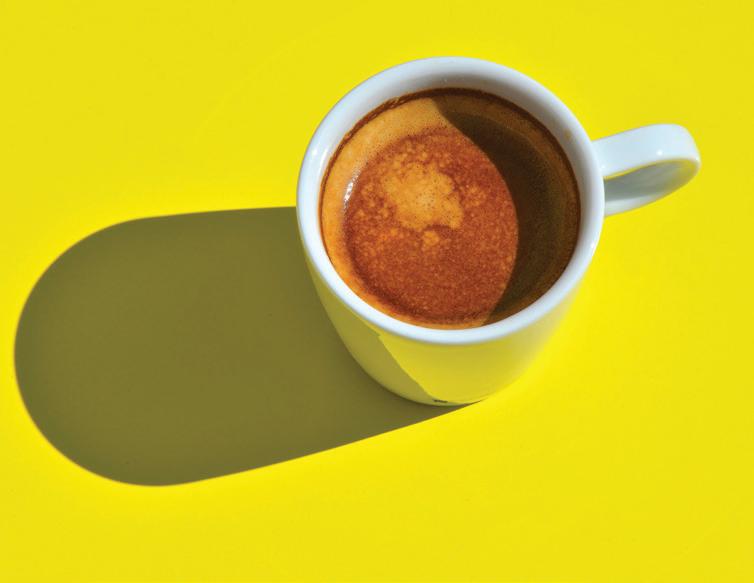
Cadbury Snaps

I can’t lie, trying to find out the name of these snacks was difficult. Cadbury snacks that look like Pringles? No idea what they were called, but thanks to TikTok I rediscovered the beauty that was Cadbury Snaps. They were so ridiculously moreish, and had all the same selling points as Pringles, except they were chocolatey. Literally what more could you ask for? I have a feeling that orange flavoured versions existed too, but perhaps that’s me just romanticising chocolate again.
Fabulous Bakin’ Boys Cupcakes
The second cake related choice, these being discontinued, was a dramatic loss to British culture. The packaging itself was incredibly iconic, but the ‘6 Choccy Cupcakes’ themselves were unbelievable. In hindsight, they were probably kind of basic, but at the time they were magnificent. I would beg my parents to buy some, and I’ve searched far and wide to find a replacement for these, but I have yet to find one. The coconut cakes were also a hit, and the spooky Halloween chocolate oranges were on par with the originals, but nothing quite beats
the sought-after six summer fruits cupcakes. I’m getting peckish now!
Campino Sweets
Marti actually reminded me that these amazing things existed, so shout out to her! Sadly, I cannot remember what these tasted like, but I vividly remember the packaging for these bad boys. Could anyone actually read the font? I don’t think so, but seeing an image of these on Google Images brought back so many memories from my childhood: the things I’d do to remember the taste of these!
Bic M&Ms
Funnily enough, I actually still ate these years after they were stripped from our shelves because my Nan always bulk bought things from Aldi, but that’s enough about her hoarding tendencies. These were so good - I used to pick of the multicoloured chocolate shells to save for later and eat the rest of the biscuit, which I just remembered had caramel in them! What a treat for us all, and thank you to my Nan for still having them in the cupboard, years after expiry.
Nostalgia rules: York Family-Run Butcher’s Celebrate 50 years
Where we buy our food from has changed dramatically in the last century.
From walking up and down the postwar bunting-lined cobble streets of England, nipping into the greengrocer (who you knew by name), chatting with the butcher (who was probably a family friend), and bumping into the fishmonger along the way, food shopping was once an entirely different experience (I admit, I may be basing most of my knowledge of this era on TV shows like Call The Midwife, but you get what I mean).
Now, we browse quiet, sterile and clinically organised aisles (if we have the money to) or we barge our way through the clutter of our local discount supermarket.
We don’t know our food, where it comes from, and worse still, most of us
don’t even know the people who sell it to us.
There is a deep nostalgia for this era of local shopping, where everyone knew everyone, and shopping was a fun experience. However, it is a myth that this type of local shopping experience has totally died out.
In York, just last month, family-run M K Quality Butcher’s on Bishopthorpe Road celebrated 50 years of business, proving that locally sourced produce, and family run food businesses live on. The reality is, nostalgia rules. In an age of supermarket bullies and takeaway ordering from the couch, nothing beats the good feeling you get from buying local produce from the store around the corner!
You should try it.
scene@yorkvision.co.uk 9
FOOD EDITOR navya verma
Coffee?!
Dan Gordon-Potts
A questionable move from the creators of the Pumpkin Spice Latte...and one that will outrage Italians...surely?
BOOKS
Reading Outside of my Degree
Katie Preston

As an English Literature and History student, I have not read for pleasure outside of my degree in almost three years.
Granted, I haven’t read for pleasure much in general, even prior to my incredibly taxing degree, but it’s become much more prevalent since I became an undergraduate.
I used to read all the time as a child, and had a reading age that was much higher than my actual age, but since I started my A-Levels I just gradually began declining in how much I read out of what I have to. To be fair to myself, a third year History seminar relies on a wealth of reading, and once you’ve gotten to your final year for History you don’t have any lectures or workshops to teach you the content. Everything becomes self-reliant, and more importantly, self-taught.
It’s not that I don’t like reading - the poetry that I’m analysing for my dissertation has been fascinating to read. It’s just that I don’t actively seek to read outside of classes, and that really saddens me.
I’m not one of those people who make the New Years Resolution to read 50 books in a year, in fact I don’t make resolutions at all, but I do wish that I read at least a few books outside of my studying. Maybe it’s that I haven’t found a good book to read? But it’s more likely my general burn-out and TikTok addiction.
If anyone has any good recommendations, DM me on Instagram @kxtie.prxston and I’ll have a peruse.

This is where the power of the eBook begins though. The Uni might demand that you read many (many) texts during your degree, but this doesn’t necessarily mean buying is the answer. I’ve spoken to more and more second year students who are using the online editions to keep that book budget low, even zero in some cases. Who wouldn’t want to shift to the economical eBook? Life is expensive enough at the moment!
3. Organisation
me so I can effortlessly open it when exam or essay time comes around.
4. Health

This exposes a debate that, accept it or not, we are all involved in: are you endearing of the eBook or connected to the corporeal? Here are some things to consider before you pick your side:
1. Budgeting
As my last article explained, there are lots of ways to get your hands on cheap books these days. This can either be online second-hand bookshops like AbeBooks and World of Books or local bookstores (my personal favourite in York being The Minster Gate Bookshop).
2. Environment

This is definitely a factor to consider if you are torn between which type of text to go for. Using my degree as an example, we usually have around 18 texts a term; not only is that a lot of money, but also a lot of paper. If you choose the eBook, something I’ve found is that you don’t have to wait for that two weeks-delayed hard copy to finally show up. Instead, depending on the text, you merely buy or view it for free. It makes getting access to the text that bit easier whilst saving the planet as well. Win win.
This is where divisions might start. I, along with many I’m sure, love to have a book that we can personalise and submit to a colour explosion: highlighting, Post-it notes - you decide. Turning up to class with this tactic makes it look like you’ve understood what you’re doing, even if in reality you have no idea what is going on. What I’m trying to say is that how you organise yourself will influence whether the online or in-person version is your preference.
Though highlighting isn’t everything, some people like to have a physical text in front of them, whether when making notes or to refer to in class. For example, a common conundrum with eBooks is the pesky page numbers. You know someone has read the eBook when starting ‘I’ve no idea what page it was on’. This is something that makes me stick with the physical text: it is a comfort to have it next to
Headaches. We all get them, but a major disadvantage of relying on eBooks is that it means staring at screens (a lot). Nearly everyone I speak to reading the online book complains about this. This leads to the question, is it healthy to be staring at our screens even more? It might be cost-effective, but is it costing our health?
So with these points in mind, which do you prefer: has the printed book had its day as part of academic life or does it still have a vital role to play?

@YorkVisionBooks books@yorkvision.co.uk
An Ode to the Printed Book: Student Edition BOOKS EDITOR KAte Shelton 10 @YorkVisionBooks
Kate Shelton
Our generation of students are living in a rapidly changing world. This would make COVID-19, Costof-Living (even Apple Pay, perhaps) spring to mind, but there are more things than just shopping that have moved online. Believe it or not, we are in an age of endangerment, mourning the decline of none other than the physical book itself. But is this really such a bad thing?
The Confusing Nostalgia of Roadtrips
Lizzy MacKay
Recently, I was on a roadtrip to Brimham Rocks with a friend when he casually mentioned something that caught my attention, and has stuck in my mind ever since.
It was something along the lines of how grown-up we are now – the fact that we can go driving on a Sunday afternoon without our parents, and without any real need to be going there in the first place. We can go to Brimham Rocks with no other intention other than we want to go. It prompted me to start thinking about how the memories of my childhood were impacted by long car journeys, and how my relationship with roadtrips has changed over the years – from the nostalgia of counting yellow cars, to spending quality time with friends.
As a child, long car journeys often involved seeing family, who lived four hours away. My parents were in the front; I was in the back. I had my box of toys and books to entertain me, and our collection of Roald Dahl CDs to occupy the hours spent in hazy traffic jams on the A1. Often, we would shout “yellow car, no returns!”, or look for names on the side of Eddie Stobart lorries, one day hoping to catch a glimpse of one of our names. And sometimes, we would see how many car brands we could name as they passed us. We would stop for food at a small diner on the side of the A1, the smell of burnt coffee and fried bacon lingering in the corners of leather booths and slightly sticky tables. Sometimes, we would talk, but often we were quiet – the hours of driving rendering my mother silent. Then, when we finally arrived, my dad picking me up in his arms and carrying me inside.
Sometimes, it would be family holidays – a two-hour drive to the beach in the stuffy summer heat. My face and body sticky with suncream, I’d stick my hand out of the
No Such Thing as Goodbye: Berlin, Old Friends and New Memories
Two weeks ago, I missed a week of uni to travel to Berlin to see my favourite band.
Actually, I was there to see a friend that I met whilst I was travelling Australia when I was nineteen; it just happened that our favourite band was performing in Berlin while I was there.
Let me set the scene: it’s early 2020 on the east coast of Australia, in a tiny surfer town. There is one hostel, thirteen beaches and many, many long-term backpackers. Florentine and I were two of these backpackers, travelling solo with plans to relax, surf and serve coffee. After two months of living in the same hostel, we became close friends, cooking our breakfasts together in the mornings, surfing in the afternoons, and spending many hazy nights in the local pub together.
Then, the pandemic happened. The whole hostel was thrown into a panic; flight prices were ridiculously high, Australia was shutting down, and we didn’t know how we were going to make it home. But, of course, we did, and Florentine and I kept in touch for two and a half years. In June 2022, Florentine flew
Lizzy MacKay
to York for a week, and seeing her for the first time since March 2020 was so surreal. Picking her up from Manchester airport was strange; she looked the same, yet so different – more self-assured, more grown-up.

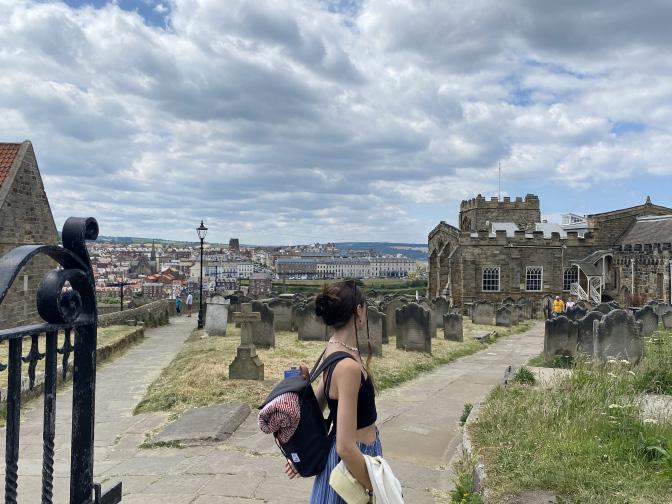
open window, feeling the wind dance between my fingers. Then, on the way home, memories of towels over the backseats, damp and sandy, flip flops on, and sand scratching between my toes.
Nothing much changed, even when I grew up. As a teenager, we still travelled once every month or two to see my grandparents. I swapped my box of toys for a bag of books, notepads and my iPod. Often, it was just me and one parent, so I was able to sit in the front seat, and watch the cars pass. I was allowed to play my own music now – no more Roald Dahl, just my parents suffering listening to me in my boyband phase. Instead of the beach, we’d go and visit universities that I was thinking of applying to. Waking up early in the morning to beat the traffic, these day trips were full of nerves: who would we meet? Where will we park? What questions do we need to be asking?
Then, on the fourth of July 2019, I passed my driving test. It felt like the world opened up to me; I grew up in the countryside, so having access to a car and a driver’s licence was freedom. I would drive up and down the country lanes, just because I could, and often drove to see friends, rather than the other way around. It also became a new way for me to go to and from work, so I no longer needed to rely on a lift to the train station, and therefore my parents, in order to earn my own money.
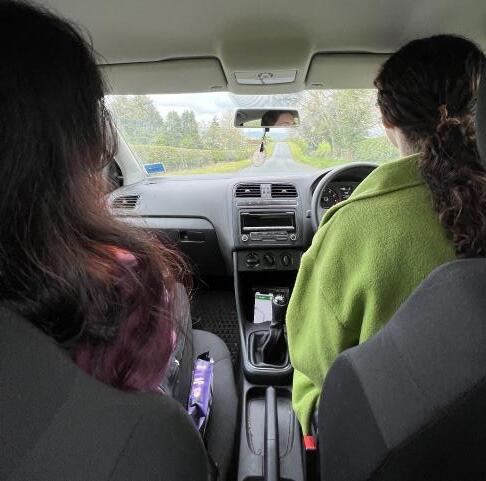

I was soon the official designated driver in my friendship group, often picking up people on the way to coffee dates or parties. I still remember the hungover drives home from birthday parties after sleeping on an uncomfortable sofa, sometimes listening to Ziggy Alberts, often in silence. But I’m not sure any of us shook off the feeling of a fresh start, a new adventure, that driving gave us.
Then, uni happened, and I was driving up to York and back again at least twice a term. It was therapeutic, but also lonely, being in a car for three hours by myself, listening to my playlist and driving along the A1. Travelling into the countryside, or to the seaside, but this time with friends instead of family, still feels so new, yet so familiar. It seems that I’m still unable to shake that confusing sense of adventure and nostalgia that comes with a long roadtrip to the beach, or drive around York into the countryside, swapping out family for friends, and my mother in the driving seat for myself.
Despite talking for two and a half years, the drive home felt slightly awkward, with Harry’s House on the radio, filling the silences. Eventually, we fell back into old rhythms, cooking breakfast together again, visiting the art gallery and Whitby. All along, it felt so surreal having someone that was such an integral part of my life in Australia be so close to me again in York.
To quote Hugh Grant in Notting Hill: it was surreal, but nice. I’m not sure if it was the stress of the pandemic or whether we are just two very similar people, but
home (in the most cheesy way possible).
And now, less than a year later, I was experiencing a slice of Florentine’s life: taking the Berlin subway, visiting her university, and walking around local art galleries. The first night I was there, we saw our favourite band, and it felt like a full circle moment, from listening to them on the humid sandy beaches of the east coast to having them right in front of us. It was as if we were given permission to become our 19 year-old fangirls again.
I really had the feeling that our friendship was evolving in real-time – from spending lazy days in the sea to roaming the streets of Berlin. We walked and walked, through the Brandenburg Gate, Checkpoint Charlie, the government district and many vintage stores and bookshops. I really felt myself beginning to embrace Berlin as a city, and by our third day we had fun dressing up and “pretending” to be locals.
On our final evening, we went to a bar recommended by Florentine’s housemate, and had a couple of drinks. It felt like old times, except we realised that we’d never been on a night out together,

which felt so wrong. Despite our determination to make it to a techno club, we didn’t end up going out this time, either.
The morning that I left, we went for brunch at a plant-filled vegan cafe a couple of stops away on the subway. Although we were so nostalgic about the end of my visit, I couldn’t help but feel that this wasn’t the end. However much time we spent apart, whatever cities we moved to, we will always be able to find our way back to each other and feel that nostalgia of our lives when we were nineteen years old again. However, this time, we know that we’ll be able to create more beautiful, new memories when our paths cross again.
That’s the thing with nostalgia: it never does quite live up to your memories. Sometimes, it’s better.

TRAVEL travel@yorkvision.co.uk @YV_Travel 11 TRAVEL EDITOR Lizzy MacKay
Images: Lizzy MacKay
For this issue, we ran open submissions for any artists on campus to design our front cover. We loved seeing what you made, so here is another entry we had sent in...
For our next issue, we will be looking to collaborate with more artists. Keep a look out for posters on campus and on our social media pages with more details in Summer Term.
 ‘The Captain’ Design by Sam Braham @incompletemotifs
‘The Captain’ Design by Sam Braham @incompletemotifs
IZZY’S INSIGHTS
ANDREWS (they/them)
A retrospect on my time as Women and Non-Binary Officer
IN THE WAKE of elections, I’ve taken a step back from my YUSU roles and reflected on my year as your Women and Non-Binary officer. As sad as I am to see it go, I’m really looking forward to seeing the next round of officers come into the role and shake it up. I’ll be living through them vicariously as I try to write a diss, as I know many of my fellow PTO’s will also be doing.
Women Non-Binary Network (WNBN) has been my baby this past year, and I’ve really enjoyed working with my beautiful committee and watching York staff squirm as I tell them that supporting transphobic countries makes them complicit in the problem, and having a set of gender neutral toilets in your building can’t be your only move towards diversity.
My final event as WNBN Officer has been and gone and I’m still feeling very emotional about it - the GLOW project, which was a project taking inspiration from queer liberation zines in the 70’s
and York campus projects like HARD magazine and the Norman Rea Gallery QUEER exhibition, aimed specifically at gender liberation, which has been a major priority for me in every single role I’ve ever held, right the way back to student council in year 8, which was my first taste of student activism, where I distinctly remember kicking up a fuss over being the only girl in the room.
Originally, the zine was going to be a guide for York students who might engage with Women and Non-Binary events, with information about gender support services, female owned businesses in York, safe binding techniques, all of that relevant stuff. But as we (in this situation, ‘we’ was myself, Hannah Burchett, B Slattery, and Thea Leeming, some of my wonderful committee and brilliant activists in their own right) began to talk the idea out, it became more of a celebratory concept, as opposed to an information provision.
We wanted to be able to promote student talent and diversity,
instead of making an information booklet akin to the pre-existing Signposting Guide, created two years ago by previous Community and Wellbeing Officer, Kelly Balmer, because that guide STILL has an amazing reach and doesn’t need to be replaced by another identical piece of work.
We had to do a lot of thinking about how to do this, as we wanted to ensure that diversity wasn’t performative, but instead happened naturally, so we put a call out onto the instagram, not targeting any groups specifically but allowing those interested to come to us, and we gathered such a beautiful range of models, writers, artists, behind the scenes students helping with photography, decor for the launch, people coming along as sheer moral support - it brought a tear to my eye (and still does when I think about it for too long.)
We had the wonderful PH7 and Gents and Ginger performing throughout the evening, and an opportunity to raise further money for this years’ RAG ben-
AM I A GOODRICKE GIRLY?
I KNOW WHEN I came to York one of the major selling points from York ambassadors was the college system we have here.
I didn’t really get it and never really have honestly, I saw the same at Oxford when I applied there and knew it was a bit of a different approach to how most universities do it, but I didn’t really jump on the college bandwagon.
I’m a proud Goodrickian and definitely miss my first year flat and bedroom sometimes, and have been guilty of wearing my college fleece out of the house on days that aren’t just laundry days, but I don’t ‘bleed green’ and the dragon mascot kind of scares me a bit. But this week especially,

during the YUSU elections cycle, (sorry for talking about it so much it was the longest week of my life),
Only working with people from their college, making sure that they get every committee
eficiary, Independent Domestic Abuse Services (IDAS), by selling raffle tickets with prizes sourced from Portal Bookshop, SPARK, The Cat’s Whiskers, and The Van Gogh Immersive experience. At £2 a ticket and £2 for a strip of raffle tickets, we raised a good chunk of money for IDAS, who specialise in work with domestic violence victims in the Yorkshire area, so it’s a wonderful cause and we’re so glad to have been able to donate to such a wonderful local charity.
The night itself was a wonderful homage to the outgoing committee and everything we’ve stood for this year: intersectionality, celebration, beauty, and diversity, all captured by the amazing Beth Chamberlain who made everyone feel as beautiful as they looked, and the ever-excellent YSTV who managed to capture all of the emotions in the room throughout the night (thanks to Alissia and Georgia who handled a lot of speechlessness from myself and Hannah as we tried to put into words how happy we were.)
And with that, I say my final thanks to Hannah, B, and Seraphina for the night itself, Meg, Liv, Gwenllïan and Lizzy for their endless support as I came home ranting about things “not looking Y2K enough”, Ellen for the stream of vodka cokes which motivated the page layup sessions, Joe for making the journey up to York to try to win the raffle, every single model for bringing our vision to life, all of the artists and writers who trusted us with such honest and raw content, my mum because I feel like people always thank their mums when they’re thanking people, and my beautiful WNBN committee, who I’m so proud of and grateful for. As I said, I’m going to miss being the WNB Officer, but I can’t wait to see what Tilly and Sophie get up to, and I couldn’t be prouder of them both. And now I’m crying, whoops!
Image Credit: Goodricke College/YUSU
I’ve seen some people absolutely lose their minds over college loyalty or lack thereof .
member on the campaign trail, basically tackling people who are in their college who haven’t

voted for the candidate they’re repping.
I don’t think I mentioned being in Goodricke once throughout the whole week, and I put the same amount of posters in the Goodricke reception as I did in the Derwent common rooms, and in Langwith spaces - am I missing out on a major part of the Uni of York experience by not living and dying by my college, or are some colleges simply more engaging?
And just to clarify, this isn’t about any specific candidate at all, I just feel like I heard people mention their college this time round way more than I’ve ever heard it before.
And that’s with three consecutive elections cycles under my

belt, running as a candidate and alongside friends, it’s never been such a big deal before.
So posits the question I ask, is it that deep? I really don’t know. It’s a nice element of the York community, to see people banding together on the basis of which asbestos infected block they lived in in their first year, but is it actually the be all and end all?

And am I an actual criminal for sometimes agreeing that Goodricke is just a bit dead?
Who really knows honestly, and as I said, I am a Goodricke girly, so maybe that’s why I missed all the excitement.
COLUMNS 23 Thursday March 16, 2023
LEAVING WOMEN AND NON-BINARY BEHIND @yusuwnb IZZY
FEATURES
YUSU ELECTIONS: A TALE OF LOW VOTES AND NO WAY OUT?
YUSU ELECTIONS ARE always one of the biggest events in the University of York calendar, as students flock to elect a new cohort of union representatives and celebrate the democratic choices available to them.

However, as political participation falls across the globe, this campus election saw a dramatic low in voting turnout - with only 10.78% of all UoY students adopting their democratic right to vote. That equates to 2664 students. 1.2% of York’s total population. About the amount of people who boarded the Titanic. With 2022 seeing 4408 unique voters and a 17.59% voting rate, the sink certainly seems extreme.

With the YUSU Election website suspiciously quieter this year and the flashy Election Results Night in Central Hall hosting a mere smattering of intrigued attendees, there does seem to be a notable concern given towards why campus’ most important elections received less substantial student engagement.
As one student recently stated “YUSU cares so much about elections… more than the actual government apparently.”
While this care for democracy and the unalienable right of student representation is certainly not misplaced, it does seem odd that an organisation which throws so much effort and engagement into this yearly right of passage doesn’t receive that same participation back.
Do students not know elections are happening? Or do they simply not care?
Neither appears a significantly useful answer. YUSU’s colourful graphics decorated the campus for weeks, invading Greg’s Place screens, lecture theatres and even Courtyard tables.
Candidate posters lined walkways, ensuring everyone knew to vote for them before the midday Friday deadline.
But only 2000 students did.
Certain societies do seem to be deeply devoted to the cycle of YUSU elections. Student media remains endlessly committed, delivering election supplements, 60 second manifestos and a broadcast of the night itself - giving months of time and effort to promoting election coverage. And they vote too, with student media groups often reaching voting percentages of 50% or higher.
But of course it’s their job to care.
Other less involved societies do appear invested in voting too. This year’s top society voter was Bellringing society (72%), with Labour Club (60%) a close second. Sport teams seemed equally keen to elect their new Union Sport President, with Women’s Cricket boasting an immersive 87% voting rate.
Across the larger demographics of department statistics, the results are less promising. The top department, Natural Sciences, doesn’t even scrap a 20% vote, with seemingly interested departments such as Politics and York Law School only reaching 17.21% and 14.16% respectively. Colleges fare no better, where the
highest scoring college David Kato saw only 15.84% of members voting and James College securing just 9.8% at the opposite end.
Regardless of where you look, for students less involved in the election process itself, there doesn’t seem to be much interest in selecting which candidate claims the £20k prize.
In fact there doesn’t seem to be much interest in being in the running as one of those lucky candidates either. This year over six Part Time Officer races remained vacant, with most Sabb positions hosting simple two-horse races in the end.
This could come down to general confidence in the incumbent Sabbs and therefore a lack of interest in competing to take them down at all. But again, with a prize so valuable and huge career boots associated with success in union representative roles, the lack of interest appears to signal something more ominous.
Maybe it’s the workload? Students don’t have enough time to grab a drink after classes let alone take on a whole year of Sabbatical or Part time work? They don’t even have time to write a few hundred word manifesto and nominate themselves. Sure, the process for nominations is something of a chore, and quite rightly - a task that should be taken with care, consideration and a passion for the job itself. But it’s generally no more tasking than a standard job interview?
Let’s say the nomination process IS uninspiring and tedious for a student body uninterested in political positions. But is this a good enough reason to explain why they don’t vote?
The voting process is generally quite simple. There’s no on campus voting booths, no voter registration, no ID checks. Students go online, pick a position and rank the few candidates in order. Not a costly effort - a few minutes at most? I did mine on the bus.
There’s also no requirement for students to absorb any of the various candidate materials floating around (although for democracy’s sake it is preferable). Students are smart and can infer all they need to know about a candidate’s competency from the three manifesto points listed next to their name online. So voting too seems easy enough.
But why does the voting turnout keep dropping then? Is there anything YUSU can do about it?
Well there is always the consideration that many students haven’t yet voted in any election, YUSU or otherwise. With the general election still 2 years away, most of this 21 years or younger undergrad cohort have had no reason to believe in the power of their vote. And no reason to further believe their vote could change anything.
The First Past the Post system in the UK is a particular hindrance here, creating a political atmosphere where votes appear meaningless unless supporting one of the main parties, and voters feel less power in the simple act of making their voice heard. With recent years of Brexit, Covid and Cost of Living instituting a general
disheartening in government, why should the student body fare any differently?
At least YUSU offers preferential votingalthough these preferences didn’t mean much this Election Results Night where each race largely ended after one round of vote counting, leaving quite a lot of time to kill.
Of course there is the more extreme consideration of introducing compulsory voting like Australia does. Each election all citizens over the age of 18 receive a small fine if they do not vote or do not offer an explanation for abstaining. The $20 (£10) fine is minimal and does -for the most part- reinforce a political attitude whereby Australians feel proud to utilise their right to vote. In fact, the last federal election in 2022 saw a whopping 89.82% of Aussies turnout to vote.
The fine mostly acts as incentive for the Aussies to tackle their voting papers which, due to proportional representation, often host a large variety of options (often 15-30 candidates). Obviously this is a problem in and of itself, but regarding the main focus here - are more options better than none? Are more voters better than some?
Compulsory voting of course bring its own host of queries and concerns
How would compulsory voting be implemented practically?
A fair question considering there genuinely is no way to force students to open a webpage and vote - and YUSU certainly can’t go around charging people who don’t. Maybe stronger incentives for voting are more reasonable, going beyond the general 10p per 1000 votes discount for campus drinks and instituting meaningful benefits such as course points or free election day food? Down under we also get a BBQ on election day! Utimately, this year’s 2000 votes only saved students 20p in campus beverages - a pretty minimal rate of work by any calculation.
Would compulsory voting just drive students to vote for joke candidates, our old friend RON (Re-Open nominations) or spoil their ballots entirely?

Quite possibly, and it certainly is an occurence in Australia - although there is an element of fun in seeing what chaotic names people write on their ballots to spoil it. Ultimately though, if YUSU are willing to have us elect the next President of the Union, they also need to be willing to trust the general intelligence and maturity of the student body, regardless of how we vote.
Is it fully democratic to entice citizens to vote?
Herein lies the biggest concern of compulsory voting. Is a choice a choice if there is pressure to choose at all? Honestly… I’m not sure. Ancient Greece’s founders of democracy may criticise this, although then again they wouldn’t let women or a majority of the UoY student
KAITLYN BEATTIE-ZARB EDITOR SECRETARY

body vote anyway.
And it’s here the overarching question becomes more profound. Is an election really democratic if no one is voting at all? A bold statement to be sure, but a fair question I hope?
Consider the potential of the cycle of elections as they currently stand. Low turnout amongst the student body leads to a relatively insular election pool. Those voting/running are either already in the room (candidates, Sabbs, student media, politics students) or have a friend who is running. The insular nature of candidate pools could lead to a lack of nominees and an instinctual reaction to vote for the incumbent - or simply the face they know.
Now the incumbent blessing isn’t necessarily a bad thing - generally this is a common occurrence in politics focused around a single leader (such as the US).
However, it can add to a lack of accountability for politicians, whereby an assured victory means there was no reason to hold the election in the first place, no reason to update or rethink manifestos, and no way to make sure those elected actually do their job. Again - this is not always a guaranteed occurrence- but the insular nature of elections certainly doesn’t help.
So if no one votes, the elections remain insulated from outside change or criticism, and the core concept of accountability within election cycles evaporates. I guess we’re just lucky these positions have term limits.
Of course this is an overdramatisation of what is, on the whole, a largely self aware and considerate election process on campus. It’s important to note this is no comment on the current Sabbs or YUSU - rather a question of what could be.
People are people and election change certainly seems needed to ensure that the person-driven nature of YUSU remains democratic and representative of all students for years to come.
Is strict compulsory voting the answer? Probably not. But is it better to have students voting than not - quite possibly.
And if that leaves us electing Long Boi as YUSU President next year, well so be it! I’m sure his manifesto will be a ‘quacker’.
24 Thursday March 16, 2023 FEATURES
*Disclaimer: This interview was completed before the 28/02/23 UCU announcment*
AS THE NEWS of a national pause in university industrial action hit last month, I met with York’s UCU branch to consider the industrial action so far, and where the strikes may go next.

Steven Spencer’s day job is as an Associate Lecturer of Sociology, although his time as York UCU member secretary means he hasn’t seen much of his classroom in recent weeks. Highlighting the frustration staff face and the complexity of the issues, Steven describes his work in the union and offers an impassioned plea for why staff strike.
Q: So to start, can you give us a rundown of how the UCU functions?
Steven: Well, I sit within the executive which is the committee that runs the whole union branch. The important thing to note with that is although it’s called executive, we are member led. It’s not like a business executive, it acts via the people so it’s a very democratic organisation.
I posted my reballot yesterday. We have to reballot every six months due to trade union legislation. Although we call it ANTI-trade union legislation, because six months is not very long to pursue an end of dispute.
In the case of this dispute, there’s one issue on pensions that it’s been going back to at least 2016, and there’s a second issue on pay that stretches back to about 2009, but became a real issue for members from about 2017 onwards.
These disputes were raised at our national congress and we voted to tell our national executive what to do. The ballot goes out to all members. There’s four and six weeks where you send it back in, then we have to get over 50% in favour on over 50% turnout.
Which, interestingly, would be much higher than most MPs to be elected into parliament. It’s a high threshold.
To end a dispute is similarly fraught, because when your negotiators reach their best and final position, they’ll take a view on whether to put it to members. If it’s way off what they’ve been asked to do, you will go back to employers, and say that can’t be best and final. If it is a valid settlement it’s put through a national paper ballot. And the majority have to accept it.
Q: I don’t think students were expecting the pause. Is this something UCU strives for normally?
It’s not typical. As a tactic, it’s a way of lowering the temperature really.
By pausing you’re enabling the more
KAITLYN BEATTIE-ZARB INTERVIEWS YORK UNIVERSITY COLLEGE UNION

hawkish institutions to step away without losing face. And you’re also enabling places which are more middle of the road just to have their influence because they’re not being shouted out of the room.
Q:Can you offer more detail on the various disputes themselves?
The USS pensions is where we’ve made progress. Although you can never tell until the deal is done, but it looks like there is a deal to be done there.
In terms of the pensions dispute, pausing in favour of progress on that is more straightforward. That’s negotiated with a different body called Universities UK, which is purely the more research intensive, older universities.
For the pay and conditions problem it’s more complicated because you have multiple unions (including Unison and United) in the room and they’re negotiating with an employer’s body. So what we’re trying to do is resolve the disputes of at least three unions, the interests of 300 odd employers through a regular negotiation process that’s not designed for it.
And the reason we’ve ended up there is because since 2009, we’ve lost circa 25% of our real terms pay, and I think it’s become very apparent since 2018/2019. Just the effect that’s having- inflation pointed out in a very visceral way. It’s really helped members to realise now it’s not just us. The employer’s pay offer for me would be 5% for this year, and it was 3% from last year.
The second condition is workflows, the third one is pay gaps, which is gender, disability and ethnicity based pay gap, and the fourth is precarity. Precarious employment for those on casual contracts.
Q:What do these disputes mean for York going forward?
The background of that is that York, for example, is growing. So the University of York wants to grow student numbers by about 4000 to 5000 over the next five years. But it wants to relatively reduce its staff bill from 62% to 52%. Now, you don’t need to be a mathematician to figure it out.
Because of the growth you could end up with a very high workload model in some parts of the university and relative under investment in others.
With precarity, locally, we’ve made some progress. Our GTAs are now on proper contracts. What we want nationally is a framework on how to deal with those four fights. We don’t want people to choose their next career step based on where it is least worst.
We’re on the fourth day of the first week of two weeks of intensive negotiations, where the employees have said ‘the pay deal is the pay deal we can’t afford more’.
And we’ve said ‘ You’ve got to.’
The counter argument is students - but
the student finance system is broken and you’ll hear our Vice Chancellor say ‘that every pound of cost of teaching home undergrads, they only recover 87 pence in tuition fees.’ Now that’s a fact. The 9000 tuition cost hasn’t moved in years.
Q: Charlie Jeffery’s has also stated ‘the system is broken’. Is that something that you and Charlie can agree on?
We agree that the student finance system is broken. It doesn’t deliver on a macro level. It’s unsustainable for the government and universities. It certainly doesn’t work on an individual level. And the idea that the whole cost of an undergraduate degree or postgraduate degree for that matter should be borne by the individual is nonsensical. Society benefits (from university education).
Where we depart is stating that this is the totality of the issue. You have a situation where in this very building, politics lecturers are having to juggle offices so they can see students, meanwhile, you’re committing to a three year build of a student centre that people don’t need. You have to question priorities right?
If we were having a conversation with Charlie, I would ask, why are there not more welfare facilities on campuses?
It’s the fact we’ve got nuanced points of view. I would say ours is based on the evidence of what’s happening.
And Charlie’s is based on a view of what he thinks it should be. But we have to live with the consequences.
Q: So this dispute has lasted a long time; everytime you begin you hope it will get better… and it’s not. Surely this wears people out?
There are very high levels of stress related sickness at the moment. People are just the most tired I’ve seen and I’ve worked in schools since 2005. People and senior management - we’re all tired. And we’re having to deal with this alongside the problem that we’re not even post- COVID yet.
Also York’s housing market has gone wrong. There are staff, including myself, who have to live in Leeds because they can’t afford York. And because you need an 18 month contract to get a rental and the university only offers 12 months. So you can see how these things feed into each other.
There’s this general sense of fatigue and lack of optimism. Which considering we actually work on a pretty nice campus with a whole lot of nice people is frustrating.
Do you think this lack of fatigue and this lack of optimism as a national issue?
I think it expresses itself differently in each institution. So in York we vocally have good industrial relations. All the unions engage very energetically.
Ultimately, I do not have any union member who wants to be on strike. We just want to do our jobs. Staff want to be teaching - this is their career, this is their life and you don’t want to be standing outside in the cold instead of in a classroom.
Q: So we’re in the pause period right now, what do you think will happen from here? How does this whole thing end?
If at the end of that two weeks there is not an agreement that can be put to members then we’ll be back to strike action. And it that carries on to the next point then we will do a market assessment boycott in the summer. That will disrupt everyone and lead to a big battle because there may be paid deductions for partial performance. We don’t accept that so at which point we’ll just be out.
I can’t predict the future, but in all likelihood that will result in all out strike action, because it’s a red line. Nobody wants that. And it’s entirely avoidable.
On the pay- I really don’t know. You have a small group of Vice Chancellors who are very hawkish and you have a government that does not like unions. They’re not doing anything. So the whole sector is waiting for a Labour Government.
Q: Yes there’s this new anti-strike bill that’s been considered and a lot of Tory hesitancy to change anything - So you think the only way out is a Labour win at the next election?
Although obviously we’re left aligned, we’re not affiliated to Labour. I would say a Labour government offers more chance of the sector recovering from over a decade of industrial unrest and on sustainable finance systems.
It also feeds into the EU horizons programme. The UK is about to pull out - I can’t tell you how catastrophic that is. We won’t be able to collaborate with universities in most areas of research, that we have been doing so for 50 plus years.
It seems to me we’re paying a hell of a lot of money for something that doesn’t work. And that is the driver of industrial action in the long run.
It’s not the only driver by any means. There’s also pretending universities are businesses and getting then to answer to metrics to in the style of businesses.
The other thing I’d say is that there is a lot of complexity. And one of the dangers is when they may try and make it simple. ‘It’s us against them.’ It’s not. It’s a systemic failure.
FEATURES 25 Thursday March 16, 2023
And the union is the canary in the coal mine.
NAVIGATING MY WAY THROUGH MY TWENTIES
BY AMBER HANDLEY (SHE/HER)
I’M TURNING 20, and needless to say I am terrified. Your twenties are supposed to be the time in your life when you develop a career, get married, buy a house, and the ultimate act of adulting, have kids!
There is this expectation that when you enter into your twenties you are supposed to have your life perfectly figured out. If that is the case, then I am exceedingly behind where I should be. What do you want to do with your life?
Leaving behind my teenage years, my safety blanket stage in life, I am constantly worrying about becoming a real adult, pro-
pelled by moving ever so closer to graduating and having to answer the dreaded question, ‘What do you want to do with your life?’
Why is it that as soon as we hit our twenties, there is this insane amount of pressure put upon us?
I feel as though there is an unrealistic perception that your teenage years are carefree, and the transition into your twenties and adulthood is seamless. We immediately become so future focused, questioning whether we are driven enough career-wise and if we should start saving money.
We all had career aspirations growing up and as we enter this next stage of life, may find those aspirations out of reach or even changing. The years and experiences we missed during Lock-
down only add to this anxiety, feeling forced to make up for lost time by mapping out your future plan. Did I have enough fun?
Then for those who want to prioritise traveling, there is this other fear that you’ll be left behind as friends may advance in their career and adult journey, while you’re still traveling around Bali deciding which cocktail to order at 11am.

Never mind the societal expectations which accompany entering your twenties, there is also the fear of leaving behind your teenage years. Why did I never have that teenage romance?
The worries of ‘Did I have enough fun?’, ‘Why did I never
have that teenage romance?’, and ‘I’m not ready to leave home,’ are just the tip of the never-ending mass of doubts. I am currently experiencing many of those fears. Despite expectations and domestic pressures, the majority of those entering in their twenties, or those well into them, will still be figuring out who they are, let alone what makes them happy.
We have experienced so little of life, yet are expected to know how we want to spend our time and be underway in achieving it. There is so much going on at this time in life, with studying, working, relationships, friendships, mental and physical health, you can become swept up in its mess and wake up one morning having missed it all.
IS ‘WILD’ THE WAY TO GO?
Why is it that as soon as we hit our twenties, there is this insane amount of pressure put upon us?
I want to enter into my twenties with my eyes wide open, although I’d be lying if I said I wasn’t terrified.
I am currently deciding what career I want to go into, where I can see myself living, and wondering who will accompany me in this next stage of my life. But despite all of those worries, I am so excited to see who I become, who I meet, and where my life takes me. Kids, marriage, and a career can wait for a while.

For now, I just want to enjoy where I am in life.
ARE SUSTAINABLE, NATURAL PRODUCTS WORTH IT?

ABOUT A YEAR ago, my friend insisted that I tried WILD deodorant the “sustainable natural deodorant that works!”
Now, it’s safe to say that when she sent me the link with the attached text “hey Em you should give it a go, oh and also if I refer a friend I get money off!” I absolutely thought this was just going to be one of those Instagram fads. Anyhow I helped her out, gave it a go and nearly two years later I’m hooked.
As a brand, WILD markets itself on being a product for life. As a company that is aware of how many plastic bathroom products get thrown away every year, WILD is on a mission to change the throw-away culture of our bathroom routine.

It’s simple really, and works like this. You pick a reusable plastic deodrant applicator. They come in a range of funky colours and designs so you can personalise it to suit you. After this you pick from seven natural and great smelling scents that come through your door as cardboard refills for your applicator.
The brand works as a supscription service which initially put me off.
Often when having to subscribe to something it seems daunting and I was sceptical about how cost effective it would be.

However, you pay £15 every 8-14 weeks depending on how often you would like refills sent out. The refills come in packs of 3 and as a rough guideline last you for around a month.
When broken down, for me this actually works out cheaper than the regular spray deodorant bottles I was buying. Oh, and it’s way more sustainable- win win!
I know up until this point I’ve probably come across like I work for WILD or something but I promise I don’t. (Although WILD if you did want to give me a brand deal please get in contact!)
Cost wise and sustainability wise there is nothing not to love. But, how have I found my experience of actually using the product?
My current subscription scents for anyone wondering what I smell like, are Jasmin & Manderin Blossom, Orange & Neroli, and Mint & Aloe Vera. Overall I have found that the scents are fresh, strong and
last me a long time. The texture of the deodorant is like a paste. It feels nice to apply and isn’t sticky. My only criticism would be that sometimes the deodorant can leave white marks on my clothes if I rush to get dressed too quickly!
All in all though, my experience of WILD has been great and I would highly recommend to anyone who is looking to slightly change up their morning routine all in the name of becoming more sustainable.
The latest venture for WILD is their coconut and vanilla shampoo bar, something that of course I’m trying.
So far so good, but you’ll just have to let me know if anyone actually wants a sequel to this article. Maybe ‘Emily Reviews’ should become a feature of
SCENE? After all, I’ve got to create my legacy somehow!
LIFESTYLE LIFESTYLE LIFESTYLE TEAM 26 Thursday March 16, 2023
BY EMILY SINCLAIR (SHE/HER)
AMBER HANDLEY (SHE/HER)
THE SCIENCE BEHIND THE CONTRACEPTIVE PILL
BY KATIE PRESTON (SHE/HER)
I HATE BEING on the pill.
I’ve been on it for almost eight years of my life, which is terrifying, and I’ve been on the progesterone only pill since the beginning of university.
For those who are unfamiliar with what that means, it means that I haven’t had a period for three years, and that I was only having what’s described as a ‘withdrawal bleed’ since I was thirteen.
I haven’t had a proper period for eight years, and I started when I was nine. So I’ve actively chosen not to have a period for almost the same amount of time that I was biologically unable to. That fact is terrifying.
I’ve changed pills more times than I can count during my eight years of using contraception, and it’s usually not my choice. When on the combined pill, in which you take a hormonal pill for three weeks and none for one week, I changed pill brands at every renewal appointment, and it was never my choice. I’d go from Levest to Rigevidon to Lovima to Gedarel to Microgy-
non to Logynon, and those are only the ones I’m confident I have taken.
For those unaware, all of these brands are the same type of pill: combined 21-day pills. The only difference is that some are monophasic and others are phasic.
Monophasic is the most common type of contraceptive pill out there, and each individual capsule has the same amount of hormone, so sachets don’t have dates on them and it doesn’t matter if you take them in a random order.
Phasic, however, contain approximately two or three sections in a sachet, and each section contains different amounts of hormones, so it does matter which order they are taken in otherwise your body can briefly become hormonally out of balance.
The one type of contraceptive pill I didn’t take is every day (ED) pills. These have your usual 21 ‘active’ pills containing hormones, and seven ‘inactive’ pills without hormones. In this case,
one pill is taken each day for 28 days with no break between packets, and the pills once again need to be taken in the correct order.
The NHS state that you can start the combined pill at any point during your menstrual cycle, with guidance only needed if you naturally have a shorter cycle and additional contraception may be needed during the first few days of being on the pill - easy peasy.
The progesterone-only pill (POP) is quite different. There are two types of POP pills: the three-hour ‘traditional’ pill must be taken within three hours of the same time each day, whereas the 12-hour ‘desogestrel’ pill must be taken within twelve hours of the same day, and regardless of which type you have you cannot miss a pill, and there is no break between packs.
If you are capable with a calendar, you can see how changing from a combined pill to a POP pill can be troublesome, and thus, switching pills is an art as much as a science.
There are two ways to switch birth control pills:
No breaks - it’s important that no gap is left between ending one pill and starting another, and leaving gaps between the combined and POP pills may result in lower protection and period-like side effects.
Overlap - when switching contraceptive pills, sometimes it’s advised to overlap both forms of protection for the first few days, ensuring that the individual is protected by the original method whilst the body gets used to the hormonal changes caused by the new pill.
Both methods however can result in side effects. When changing from the combined to the POP pill, or even between monophasic and phasic pills, period-like side effects are common for up to three months, including headaches, nausea, spotting, mood changes, and weight gain, symptoms that are all common to those who have their menstrual cycle unmedicated.
The most terrifying side ef-
fect of changing pills, and the pill in general, is that your eyesight legitimately worsens. The contraceptive pill causes the cornea to thicken over time, causing blurry vision and irritated eyes, so if you’ve been on the pill for a while and notice your eyesight deteriorating, go to the opticians!
All in all, why is the contraceptive pill so difficult? Various breakthroughs in male contraceptives have been made, but when faced with the all too well known symptoms of weight gain, anxiety, depression and awful skin, ‘further research’ was apparently needed.
Even in 2022, a contraceptive pill for men that is 99 per cent effective was trialled, but side effects were unacceptable, meanwhile I have an ever-increasing risk of breast cancer, ovarian cysts and the dreaded blood clots, so maybe scientists need to put more work into reducing those ‘side effects’.
THE NORTHERN LIGHTS RETURN TO YORKSHIRE
THE SCIENCE BEHIND THE AURORA BOREALIS
 BY EMILY SINCLAIR
BY EMILY SINCLAIR
JUST AS FEBRUARY came to an end, the Northern Lights were spotted in Yorkshire! Yes, you heard me right… Yorkshire! I guess “northern” is in the name! How does this natural phenomenon work and how come we can sometimes see it yet most of time it remains a mystery?

Theories about the Northern Lights, or the aurora borealis as it’s also called, have been troubling physicists and scientists for years as the debate remains: how do green, blue, and purple lights suddenly appear in our sky?
The scientific understanding is that the natural light show is caused by a disturbance in the sun’s pull on the Earth’s magnetic field.
‘When the Sun’s pull gets disturbed, lights are created!’
These disturbances cause waves, known as Alfven waves, that send electrons at high speeds into the Earth’s atmosphere and create the light aurora that we then see. To put it simply then, for those like me who were never good at physics, when the Sun’s pull gets disturbed, lights are created!
The sun is a star that is prone to dis-

turbances- geomagnetic storms occur a lot within our atmosphere. When the disturbances are very powerful, they can cause the Earth’s magnetic field to be affected and pulled as well.
The result of this pulling is that, like anything that is pulled, it has to be released again soon enough.
‘The molecule reaction causes the light aurora.’
When the magnetic field is released it produces the Alfevn waves which travel faster and faster as they move back towards Earth. Within the waves are millions of little electrons which react with
the nitrogen and oxygen molecules in the atmosphere. This molecule reaction causes the light aurora.
The northern lights, as the name suggests, are visible from the Northern Hempisphere.
‘On clear nights they can be seen from the UK.’
On clear, dark nights they can be seen from the UK although this is rare. So, if you managed to catch a glimpse of them the other night then count yourself lucky!
SCIENCE SCIENCE EDITOR SCIENCE
27 Thursday March 16, 2023
OLIVER FISHER
(SHE/HER)
CLIMATE

THE END OF FOOD WASTE?
 BY JOE LEE
BY JOE LEE
FOR YEARS THE ‘app space’ has been integrating itself into every aspect of society; everyday, people spend hours upon hours on their devices, scrolling Instagram, Facebook, Pinterest and so many more apps.
Over time it becomes more and more monotonous, almost gratuitous. But what if it didn’t have to be that way, what if there was an app at your fingertips that could be entirely positive, benefitting society as a whole, saving you money and allowing you to eat high-end items for cheap or even free?
In the grocery space there are apps that can track expiry dates, give you meal plans and coupons to save money, but the best of these are apps like Too Good To
Go and Olio that help put an end to one of the largest environmental/societal problems facing restaurants, bakeries and your average citizen – food wastage.
What happens when a large popular food chain like Greggs ends its’ day with spare pastry and sandwiches?
The Too Good To Go app answers this question, no longer does good food have to go out of date and into the bin. Now whatever isn’t sold during the day goes into a ‘magic bag’, an assortment of ‘sandwiches, bakes, and sweet treats’ sold at a deep discount. A perfect solution.
Even the University’s own Greggs have this offer, and for students concerned about money and inflation on the rise this can be such a beneficial and practical way to treat yourself to something delicious.
Many business around York

operate on the app, and it isn’t just what items don’t sell by the end of the night that are on the app.
Pear Tree Farm and Toby Carvery offer both regular and vegetarian breakfasts to be rescued at reduced prices, even the beloved Starbucks offer a morning bag at £3.99 (at what would’ve been a price of £12 normally) that could contain wraps, juices, pastries, yogurts and more. The app is completely free to use, all you have to do is sign up, reserve yourself a bag and go pick it up.
In 2018, the UK produced 9.5 million tonnes of food wastage! For a long time now, food waste statistics had been shocking globally, but the UK was notably disappointing.
The pandemic was an interesting period to analyse food wastage, as more people were stuck at home, going out shopping was a dangerous expedition and the
‘Eat Out to Help Out’ scheme was introduced by the government as business were struggling to survive. As employment became progressively less secure, so did money and assets, and UK citizens had to adopt food wastage skills.
The benefits of this adaption were clear, but as the world returned to ‘normality’ and the stress of everyday life come back, the food wastage returned to its pre-pandemic state.
According to the Food Waste Survey (2021), 44 per cent of UK citizens felt time pressure in their everyday life, again similar to how it was before the pandemic. Batch cooking and defrosting took the biggest hit, falling the most between November 2020 and June 2021.
We all have behaviours that can help in the fight against food wastage, and its often such simple
tasks that can save the world in their own little way that go unrealised, even just checking the fridge before shopping can be such a beneficial act if the whole world did it.
Olio is an app where people who may have bought extra food or have food quickly reaching its expiry date can give away this food free and similar to Too Good To Go all people have to do is sign up, reserve an item and collect it. It’s not always the case that everything gets collected but just being a place where you can reduce food wastage is crucial nowadays.
The people and companies on these apps have saved thousands of meals across the country, and you can too, whether you’re offering or collecting, the ability to protect the planet is at your fingertips.
VIDEO GAMES AND THE CLIMATE CRISIS
BY JOE LEE
EARLIER THIS YEAR, Microsoft announced it would be updating its Xbox standard shutdown mode. Moving from ‘Rest’ – a mode that makes the console quicker to start up but consumes a considerable amount of power – to an eco-friendlier power saving shut down mode (reducing power from 15 watts to two watts), with mostly similar features, bar the extra 15 seconds it would take to start up.
This sparked outrage, despite being better for the environment and saving people money on their energy bills, all people could concern themselves with was the extra time it needed, the clear impression being left that users of X-Box prioritise self-interest over what should matter.
From this ordeal a question was sparked, what is the video game industry doing to reduce its carbon footprint? From creation to distribution of both consoles and the games they allow the world to play, there are emissions, excessive power use and other works of human influence that negatively impact the world we live in, so how does this industry improve without damaging its questionable userbase?
Despite its negative reception, the power saving standby mode is only one of many possibilities facing game developers in reducing their environmental impacts. Another of Microsoft’s achievements is the use of post-consumer recycled resins in its controller, for example a “portion of resin from recycled materials like automotive headlight covers, plastic water

jugs, and CDs.”
The most obvious way to begin a cycle of healthier production would be to use renewable energy sources. This could have an immediate impact and, according to Simon Hayes (CTO of Wargaming Sydney), one which could be done with ease and in multiple ways. Not only can renewable energy be bought but the installations of solar panels could also create the renewable energy, in turn saving the environment and the companies’ money. There are also in-office decisions that apply to many businesses around the world like reducing use of single-use plastic, getting ethically sourced office supplies, and making sure employees recycle their waste. This again would be a smaller but immediate impact, and in the long run even the smallest of efforts
can go a long way to offsetting their carbon footprint.
EA even goes as far as to have installed room sensors such that lights only turn on when needed, and LED lighting to ensure as little power use as possible while still being practical.
Google, though lesser known for its videogame platform, is a leading example for tech companies to strive to. In 2007, Google become carbon neutral, relying heavily on renewable energy and is currently applying “machine learning (AI) to drive energy efficiency even further.”
Microsoft intends to become “carbon negative” by 2030, Apple to be carbon neutral by the same year and Amazon intends on carbon neutrality by 2040, but is it too late? To the leaders of these big tech conglomerates it may seem
daunting as almost everything would have to change in order to pave a way for an eco-friendly future, but like in many aspects of environmental damage there are a multitude of simple and easily implementable adaptions businesses can make.
The doomsday clock is always ticking but there’s still time and some hope for a future in which companies from not only the videogame industry but every industry become a success in the sustainability movement.
In summary, although climate damaging effects may seem like an irrepressible cog in the industrial machine, hold on to hope that the video-game world may yet change.
CLIMATE
JOE LEE 28 Thursday March 16, 2023 CLIMATE
EDITOR
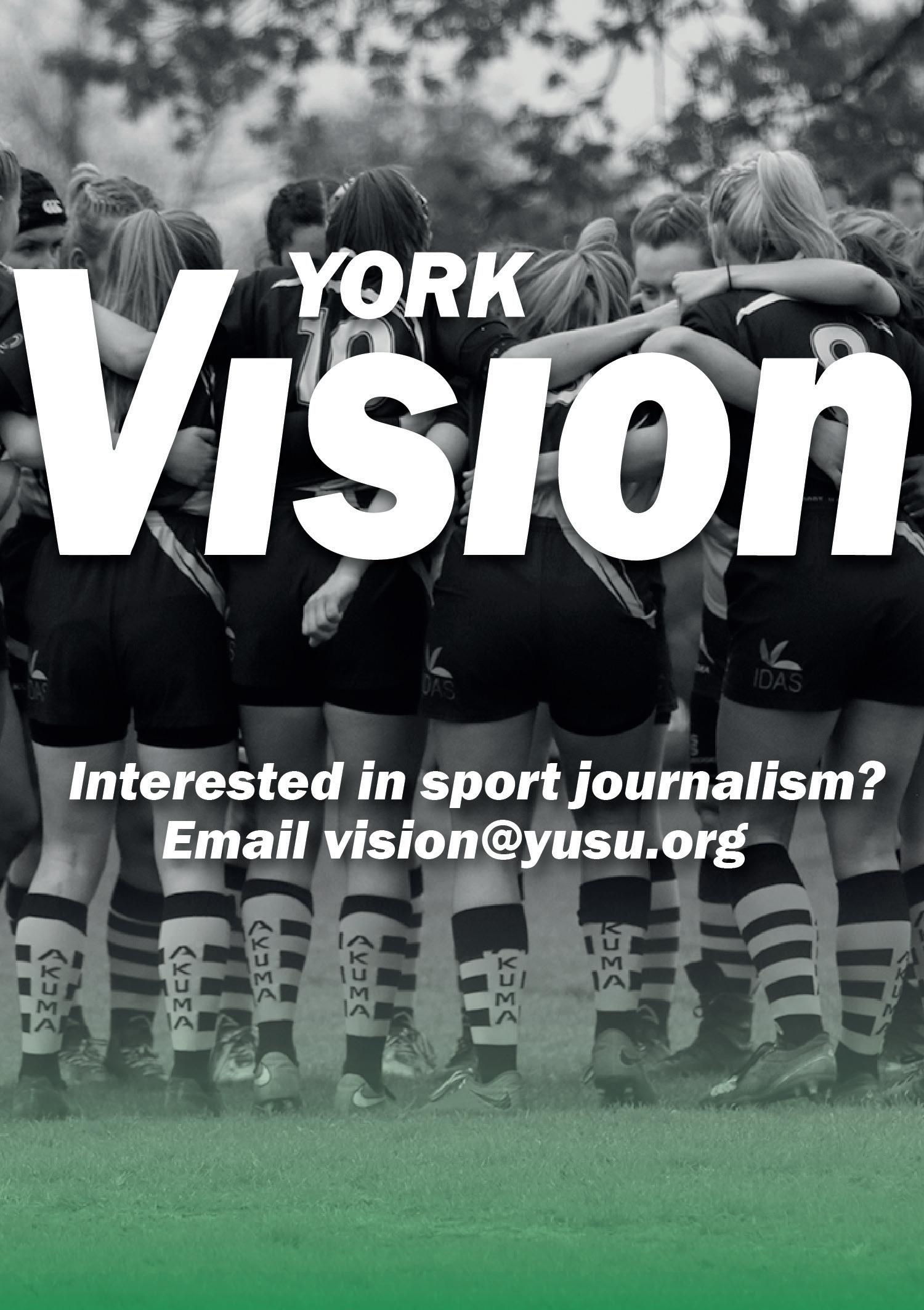
ELECTIONS 23’: FRANKI RILEY
SPEAKS TO VISION
YORK VISION INTERVIEWED YUSU’s outgoing Sport Union President Franki on her time as Sport President, her favourite memories in the role, and what advice she would give for incoming candidates.

Q:What does the role of Sport President entail?
Principally, being the key student-facing contact for all university and college sport clubs and designing and implementing initiatives and projects designed to improve the student sporting experience. You also work as a key representative for the university on student sport matters – but it’s really important to consider how you best represent over 3000 sporting students, and ensure their voices are all considered and heard. You lead the York Sport Union and College Sport Committees, made up
of student volunteers and enable them to work on exciting projects and manage key functions of the sport systems. You also take a lead on planning and delivering key sports events such as College Varsity and Roses and support student and club-led events where required.
Outside of sport, you work collaboratively with the rest of the Sabbatical Officer team on key issues impacting students, such as Cost of Living, Industrial Action and so on. I could go on and on… but the best thing is you get to shape what your role looks like, so make it your own!
Q:Is there anything you wish you had more time to work on, and what advice would you give this year’s applicants?
I am in the early stages of drafting an Accessibility and Inclusion in Sport policy, which will cover lots of aspects of gender inclusion, LGBTQ+ inclusion, inclusion and accessibility of sport for disabled students and more. The reality is any work
I do on this will need to be continued into future years to ensure thorough implementation and so that everything covered becomes second nature. This is an area of growing concern for our students, and I’m hoping my work provides a very solid foundation upon which to be built, and I would therefore encourage any applicants to consider how they will promote inclusion and accessibility in their manifestos. In terms of advice: look after yourself – this whole process can be very daunting and intense, so make sure you put yourself and your mental health first. Create a strong support network around you, and where you can delegate campaign tasks to this network too, the more help you have the easier it is to get your message out there. Keep an eye on your social battery – during campaigning you are likely to speak to a lot of people so make sure you give yourself time to recover between the days. Campaigning is equally about you getting your message out there, but also about
listening to the concerns, needs, and ideas of everyone you’re interacting with – so remember to listen too!
Q:What changes/progressions do you still think need to be made at the University in relation to sport?
Facility development – we are making progress on this but there is still a long way to go to have new sports facilities built on campus. This must also factor in storage! This is a very exciting project that many previous Sports Union Presidents have worked on, and that future Sports Union Presidents will also be able to get involved in. These developments are so crucial because students are being forced to choose between lectures and their sports activity, which can hugely limit participation and engagement.
I also still think we have a lot of progress to make on the inclusivity of our sports and activity offerings at York. This is something I am actively working on, but we still have a long way
to go to ensure our sports activities are truly inclusive, especially for disabled, non-binary and transgender students. This work doesn’t stop just here at York, but also requires a lot of lobbying to national sporting organisers and governing bodies.
Q:What is your fondest memory of being Sports President?
Without a doubt, Colours Ball 2022. Colours Ball is the annual sports awards dinner, and has always been a key memory of my sporting experience. It is such a wonderful way to round off the year, and to be able to spend it with all of my friends and colleagues and also play a key role in delivering the event was just amazing!
Q:How would you describe your overall experience in the role?
I’ll keep this short – it’s the best role in the world.
IS ANNE LISTER AND DAVID KATO
SPORT DOING ENOUGH?
East Campus.
ANNE LISTER COLLEGE opened in January 2022 amidst controversy whereby York students ended up in Hull Accommodation for the first term of the 2021/22 calendar year, before being moved to the brand-new college for the rest of that academic year.
Meanwhile, its neighbour David Kato College opened at the beginning of this academic year as the two new latest colleges on
For this academic season, the two colleges play together as a single team in certain sports, although in Pool Anne Lister play with Langwith College and Kato play with Goodricke.
York Vision analyses how their season has gone thus far…


On an initial inspection, it has been a mixed season for York’s newest collegiate sides. For Varsity 2023, not a single representative from either Kato or Lister has qualified as either top-seed or runner-up seed to take on Durham in the 15 sports up for grabs.
However, Varsity is not nec-
essarily the be-all-end-all qualifier of collegiate sport success. In Pool, a sport dominated by East Campus colleges in the rankings, has Goodricke/Kato as second and Langwith/Lister as third at time of writing in the Table. This does seem to be the only outlier though in terms of being reasonably successful in the college league rankings.
Furthermore, at the moment, according to the UOY College Sport website, there are only representative sides from Anne Lister/David Kato in the following: Badminton, Basketball, Cricket, Football (Men’s; Women’s),
Hockey, Netball, Pool and Tennis.
So, for Rugby Union, Squash and Volleyball there are no collegiate representative sides. But is this a problem, and if it is, is it unique for Anne Lister/David Kato? Well, no, and this is a general theme with York collegiate sport in general.
Alcuin College only has sides in six sports. Is there even the demand from Anne Lister/David Kato students for better sport provision?

And fundamentally, college sport is supposed to be competitive but more fun and relaxed than the Uni counterparts. The
collegiate network isn’t necessar ily designed to be always a feeder system for players to be scouted into university sides. As far as I’m aware college players making the jump to uni sides on invitiation only really happens for Roses.
Yes, James College will always have a considerable advantage with its large student population and close proximity to the York Sport Centre and the ’22 pitches on West.
Ultimately, as long as college sport is enjoyable for Anne Lister/David Kato students and participation is high, that’s all that should matter.
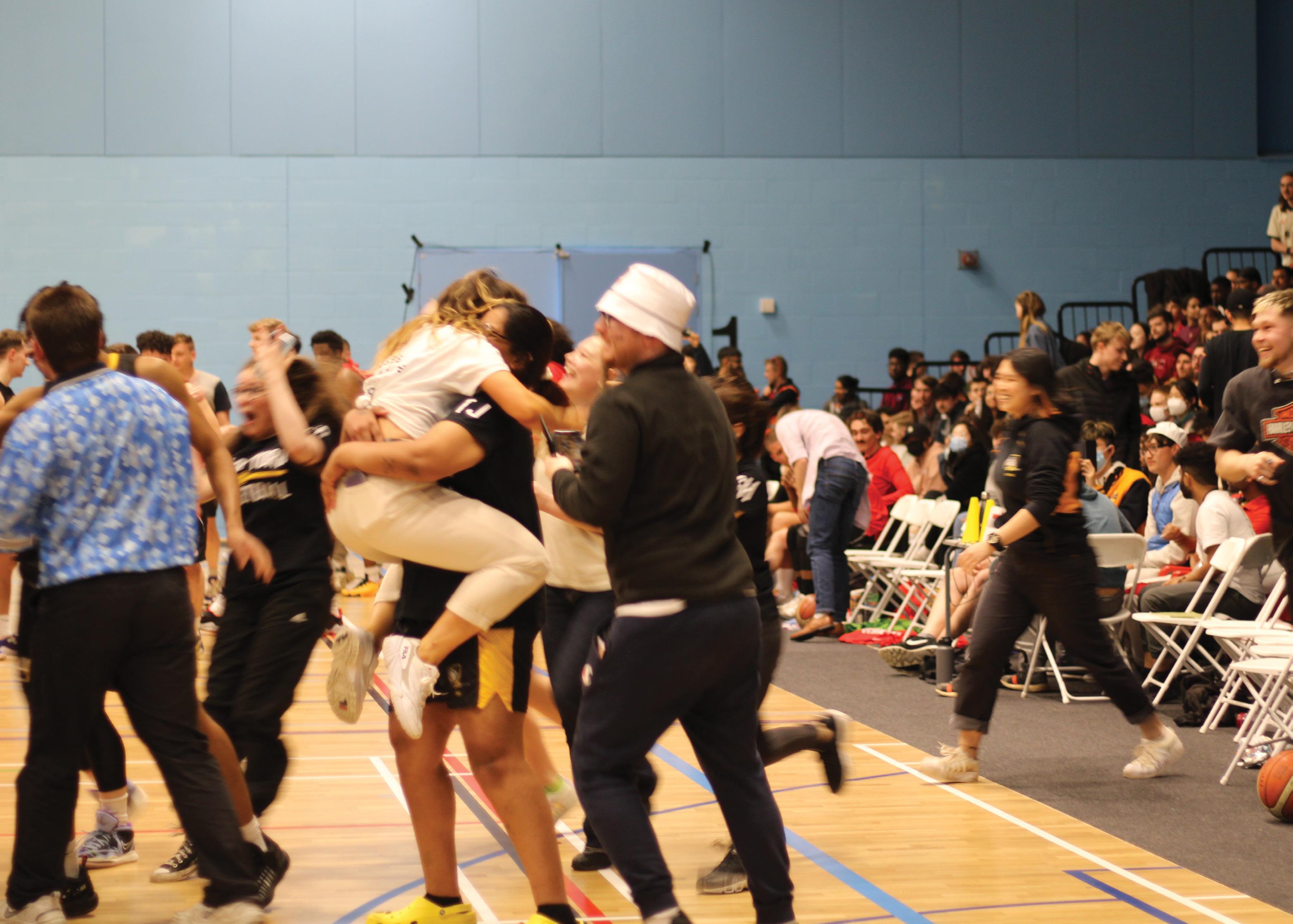
SPORT SPORT 30 Thursday March 16, 2023
1
JACOB BASSFORD (he/him) SPORT EDITOR
KATIE PRESTON (she/her) @kxtie.prxston
SPORT EDITOR
JACOB
BASSFORD
EXCLUSIVE: INTERVIEW WITH
TANISHA - NEW YSU PRES
no gender, background, age, sexuality or any other factor should act as a barrier to access sports.
FOR THE LOVE OF SWING DANCE
BY SUZANNAH BINNS
SWING DANCING
ON 25 TH FEBRUARY 2023, as part of the widespread Student Union elections, Tanisha Jain beat fellow contenders Dec Thomas and Jammy Clarke to succeed Franki Riley as President of the York Sport Union. Vision’s Sports Editor Jacob Bassford interviews Tanisha following the election.
Q: Do you think the University values sport enough?
Tanisha: I think that the university has started to value sports more and more every day, but just saying that isn’t doing anyone any good, they need to act on it. York is conventionally not seen as a ‘sports university’, but I truly believe we are one and I can’t wait to prove it to the world.
Q: Do you think the ’22 pitches are of a standard appropriate for a Russell Group university?
I think the 22’ pitches are good and definitely prove themselves to be helpful, but that doesn’t mean more work doesn’t need to be done. For a Russell Group University, they aren’t quite accessible to our differently-abled students, and could also be made to be more beneficial during winter term, which is something I want to work towards.
Q: In your manifesto you listed several pledges, what’s going to be your first priority as new Sports President?
I have said this a lot of times even before I ran for this position, that I want to make sports at York more inclusive and accessible. For someone who is a part of the BAME and LGBTQ+ community, and suffers from mental health issues, it hurts my heart to see that there are students who can’t be a part of this wonderful community because of who they are. As I’ve said before,
Q: One of Franki Riley’s last acts as YSU President was to draft what she called an ‘Accessibility and Inclusion in Sport Policy’, do you intend to carry on with this and if so what will it look like?

I definitely intend to carry on with the accessibility and inclusion policy, as I said in the previous question, it’s my main focus as the next YSU President.
For what it would look like, I want to work with Franki and look into both our ideas and thoughts surrounding this as I know accessibility and inclusion is very important to her too, but also listen to the thoughts of our students who will benefit most from this policy, that is our trans/non-binary/gender fluid athletes along with our differently-abled athletes.

Q: Any comments on James College’s intention to have a non-gendered football team for 2023/2024?
I have mentioned them a few times in other interviews, but I highly commend them for taking such an incredible step. James has the highest number of teams and to see them integrate into one non-gendered club sets an example and even motivates other clubs to make a more comfortable environment for everyone. Constantine college football is also one non-gendered club now which is amazing and I hope other clubs across various sports are motivated to do the same.
Q: In your opinion, do the York Sport Centre and York Sport Village do enough to help University and collegiate teams with things like S&C and training?

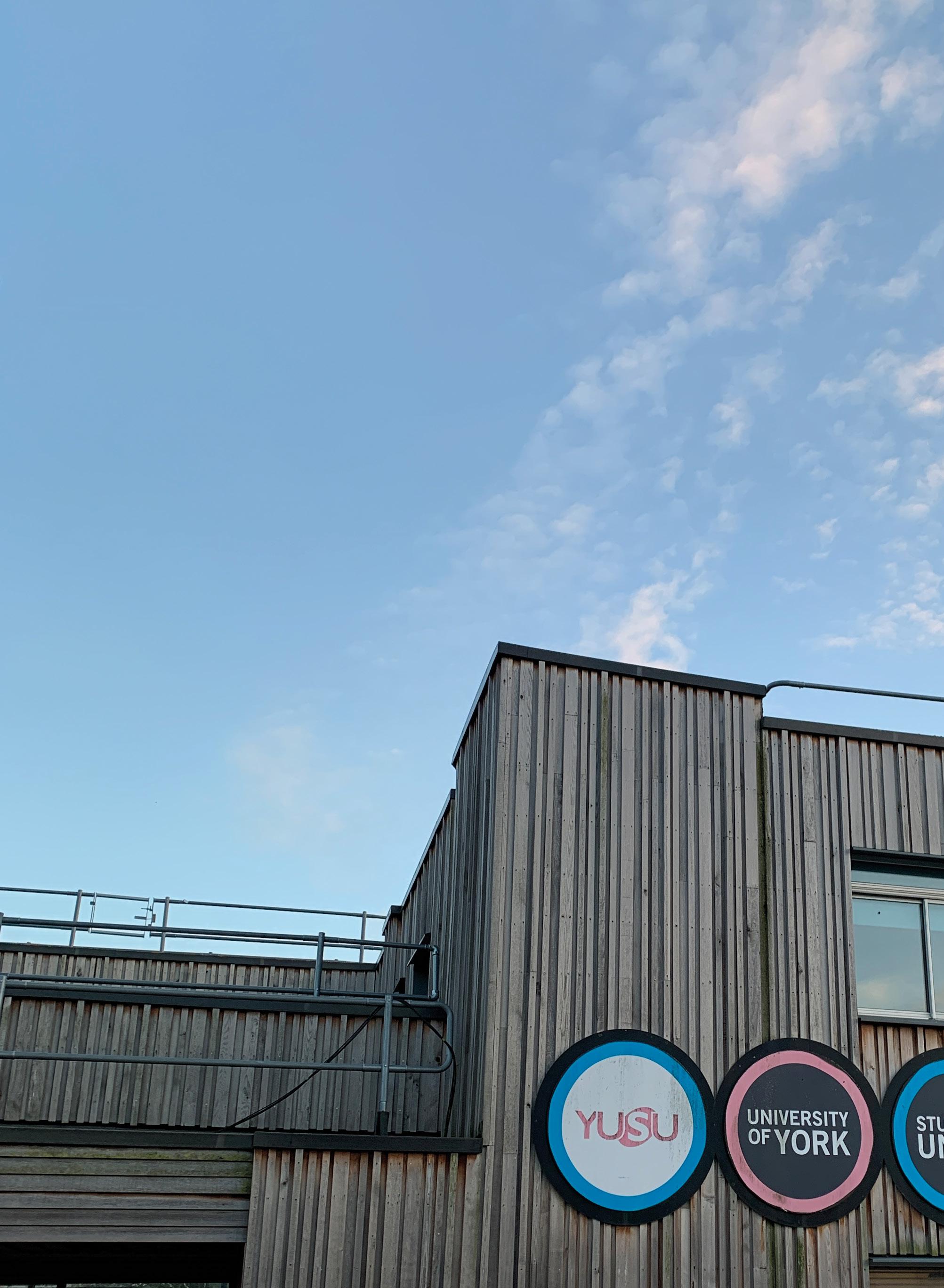
I think there is definitely more that can be done regarding S&C training since there are a couple issues surrounding it. From what I’m aware not all students and
clubs are aware that S&C training exists, and those who do they struggle to either fund it or find a good training time.
S&C is something athletes should have access to because it helps in various aspects of sports and physical health generally. I want to increase promotion of S&C training, sustain the grants we have available while also looking into ways to expand them and help get more and more clubs be involved with it.
Q: You pledged to make an audit into storage facilities as part of your ambition to improve storage access (a problem affecting all societies, not just sports clubs), do you know when such an audit can take place?
I think such an audit should take place at the very start of the academic year so then throughout the year work can be done regarding it. Storage is a massive issue that affects every society in York, be it sports or not, and I want to continue working on the plans that are undergoing, but also see how we can maximise the use of our own facilities.
Q: How does having a strong University and college-level sport system benefit both York and students?
Having a strong university and college system has a lot of benefits, from physical health to mental health, socialising and making bonds for life, to also giving one a sense of belonging. As an international student, I was accepted above and beyond in the sportingcommunity at York and it has been the peak experience of my time at university, and has honestly helped me survive the last 2.5 years.
The best thing about sports at York is the variety you get to choose from, you can play competitively and a high intensity and performance level but you can also play to have a bit of fun and socialise, or you can have the best of both
worlds. Our college sport system is one of the best in the country and we have amazing university clubs as well, and I can’t wait to make sports here bigger and better!
Editor’s Opinion:


There’s certainly reason to be optimistic, it’s nice to see that Tanisha is clearly passionate about the work she intends to carry on as the new Sports President. There’s certainly some ambition, which is pleasing to see, but it remains to be seen whether such objectives can be achieved in the next year.
Franki Riley has left the role with her head held high, but there is still a lot of work for Tanisha ahead if she wants to succeed in making York place higher in university league tables for sports.
Outside of performance, I do hope she is successful in making sport more accessible for all. Critics will be sceptical as Tanisha was seen as the ‘establishment’ choice to succeed Franki, but continuity can be a good thing and I wish her all the best for her term as Sports President.
WAS not an activity I ever thought I’d participate in, mainly for lack of coordination reasons, but also having no prior dance experience (except a brief dalliance with ballet at preschool!).
However, after a random conversation with a friend from my History group project about societies, I was introduced to the idea of learning to dance to jazz music.
As it transpires, joining Swing Dance Society has been one of the best decisions I’ve made at university. I’ve made so many lovely friends from a whole range of degree levels and taken part in various events. One of the highlights of my time so far has been taking part in ‘Whip-Ma-WhopMa Hop’, a weekend of intensive swing dancing! The weekender was a fantastic experience and a great opportunity to meet other likeminded dancers from different parts of the country.
I took part in the Beginners’ Stream, which was great fun as we consolidated and added new moves to Lindy Hop, a dance that evolved from 1920s Harlem in New York. Another aspect of the weekend was a Q&A discussion in the Bowland Theatre by the teacher Corina Kwami, which highlighted the importance of acknowledging the African-American history of Swing (something which the society does a good job in highlighting every lesson) and the exciting future of Swing Culture!
If you would like to give it a try, Swing dance classes run every Wednesday at seven o’clock until 10 o’clock in James Hall, it’s great fun, a way to keep fit and meet lots of people. You don’t need a partner. It costs £3 a lesson for non-members and £2 for members.
SPORT 31 Thursday March 16, 2023
JACOB BASSFORD (he/him) SPORT EDITOR
Vısıon YORK Sport
Thursday March 16, 2023
INTERVIEW WITH OUTGOING SPORTS
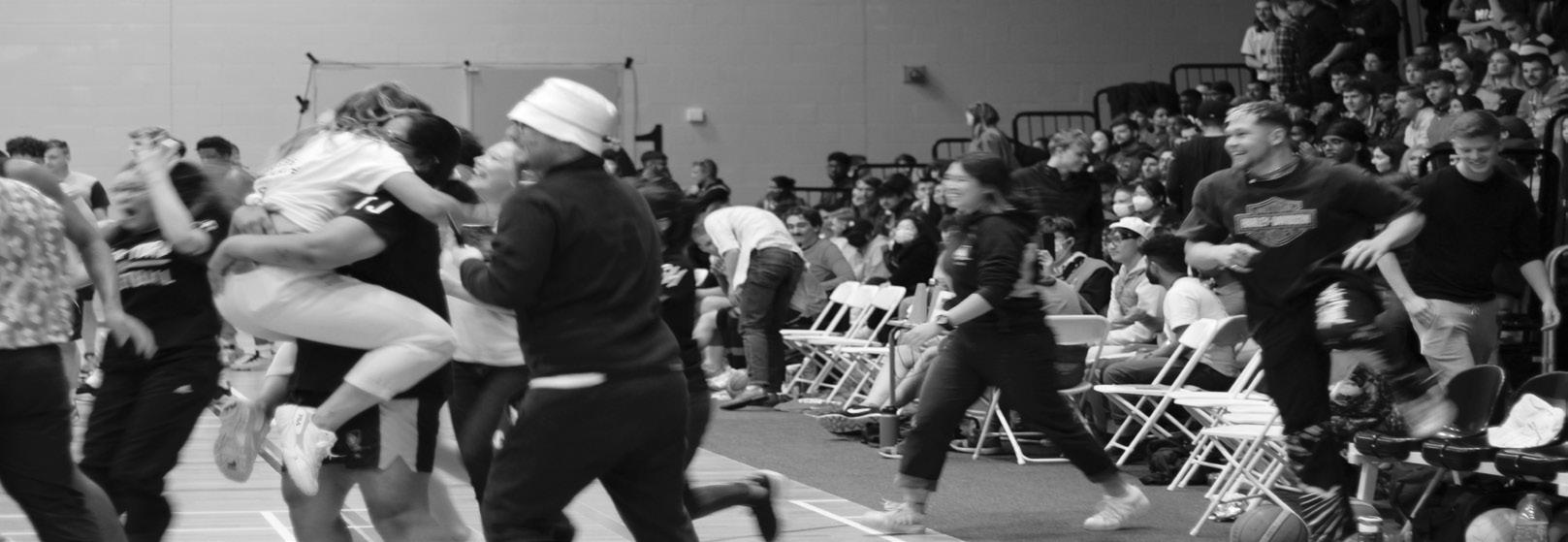
PRESIDENT - FRANKI RILEY
“MAKE SPORTS AT YORK MORE INCLUSIVE.”
NEW SPORTS PRESIDENT
Interview with Incoming York Sport Union President - Tanisha
BY JACOB BASSFORD
ON 25TH FEBRUARY 2023, as part of the widespread Student Union elections, Tanisha Jain beat fellow contenders Dec Thomas and Jammy Clarke to succeed Franki Riley as President of the York Sport Union. Vision’s Sports Editor Jacob Bassford interviews Tanisha following the election.

Q: Do you think the University values sport enough?
Tanisha: “I think that the university has started to value sports more and more every day, but just saying that isn’t doing anyone any good, they need to act on it. York is conventionally not seen as a “sports university”, but I truly believe we are one and I can’t wait to prove it to the world.”
FULL STORY ON PAGE 31
IMAGE: YUSU
PAGE
30









 BY KAITLYN BEATTIE-ZARB
BY KAITLYN BEATTIE-ZARB


























































 ‘The Captain’ Design by Sam Braham @incompletemotifs
‘The Captain’ Design by Sam Braham @incompletemotifs










 BY EMILY SINCLAIR
BY EMILY SINCLAIR


 BY JOE LEE
BY JOE LEE











